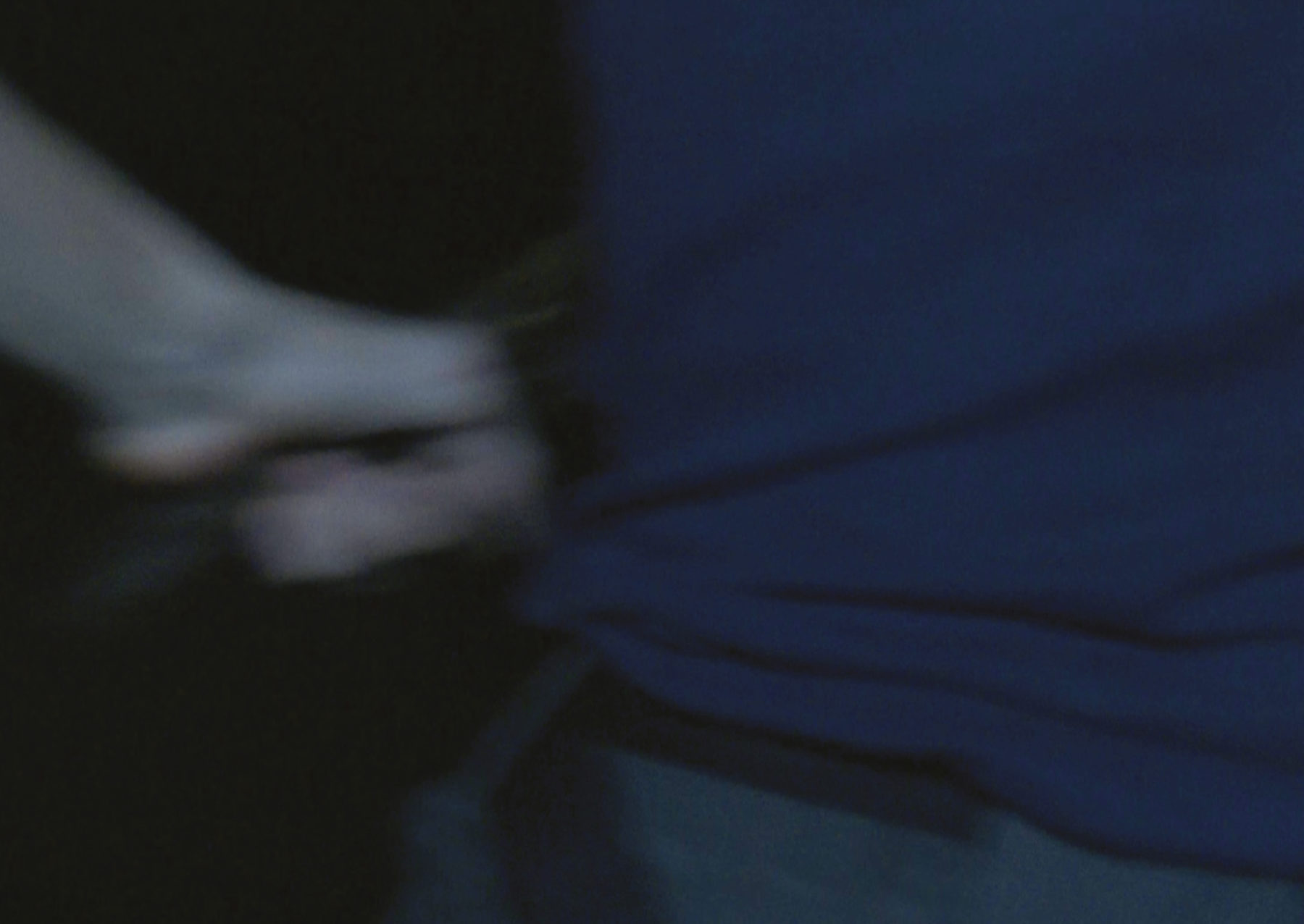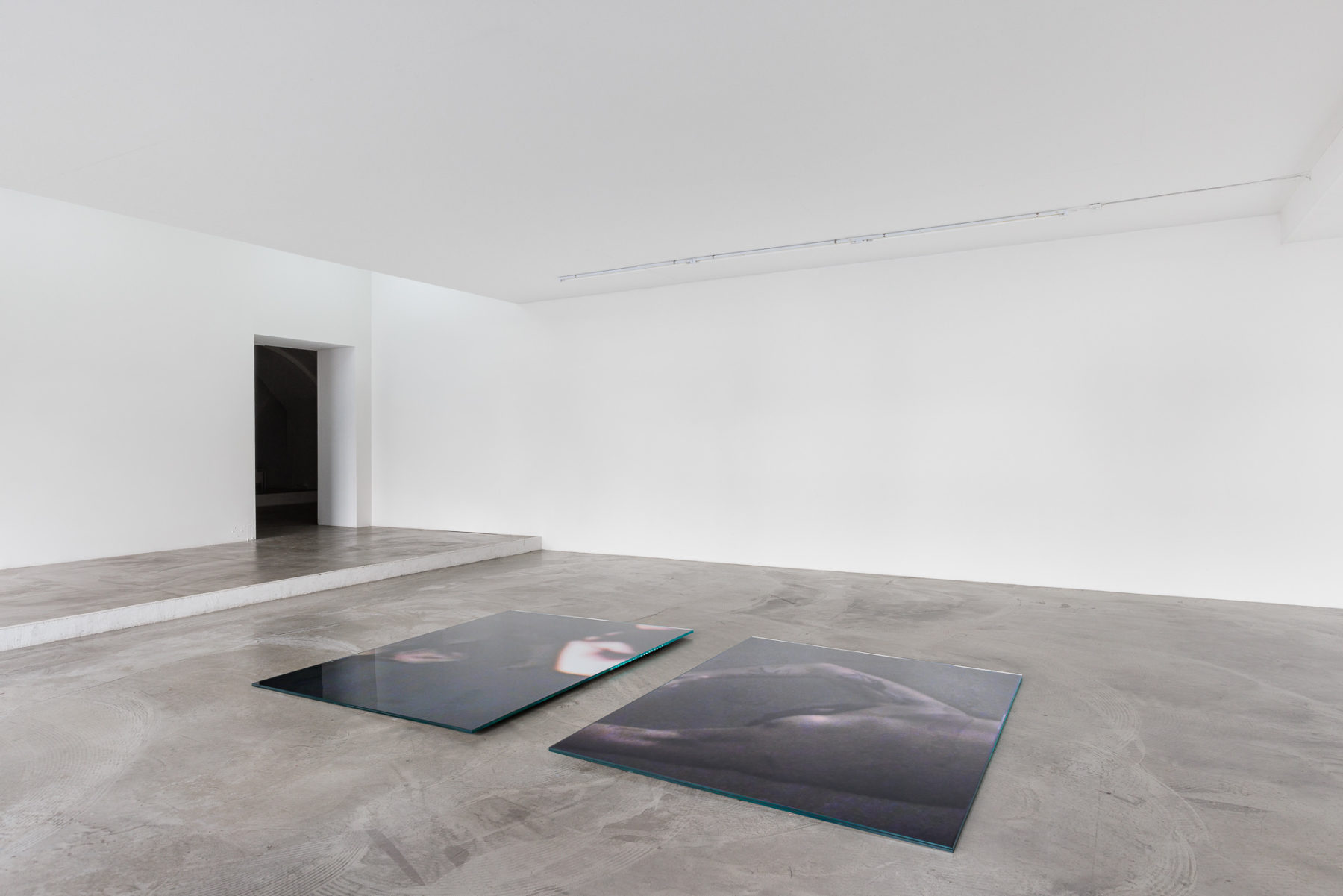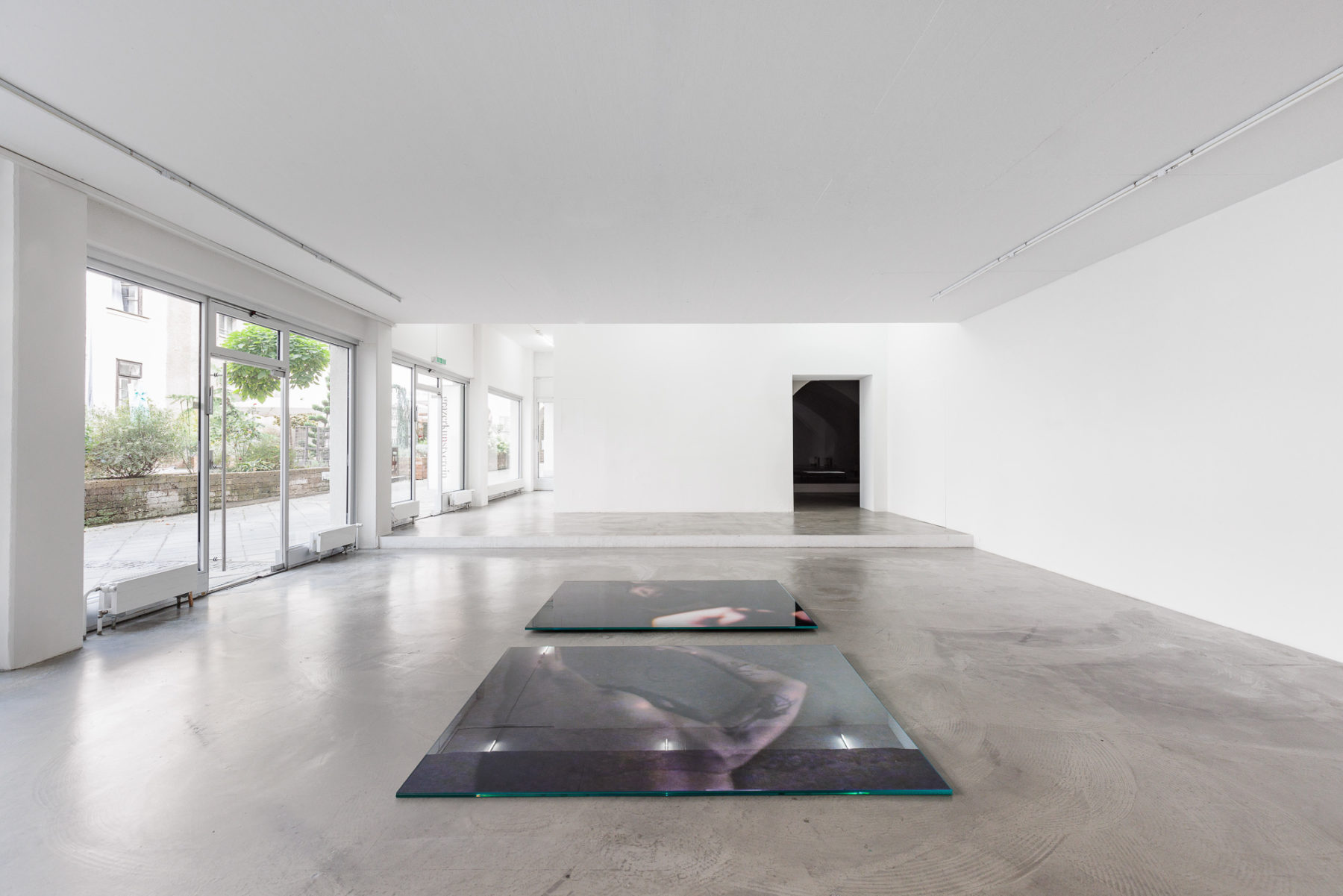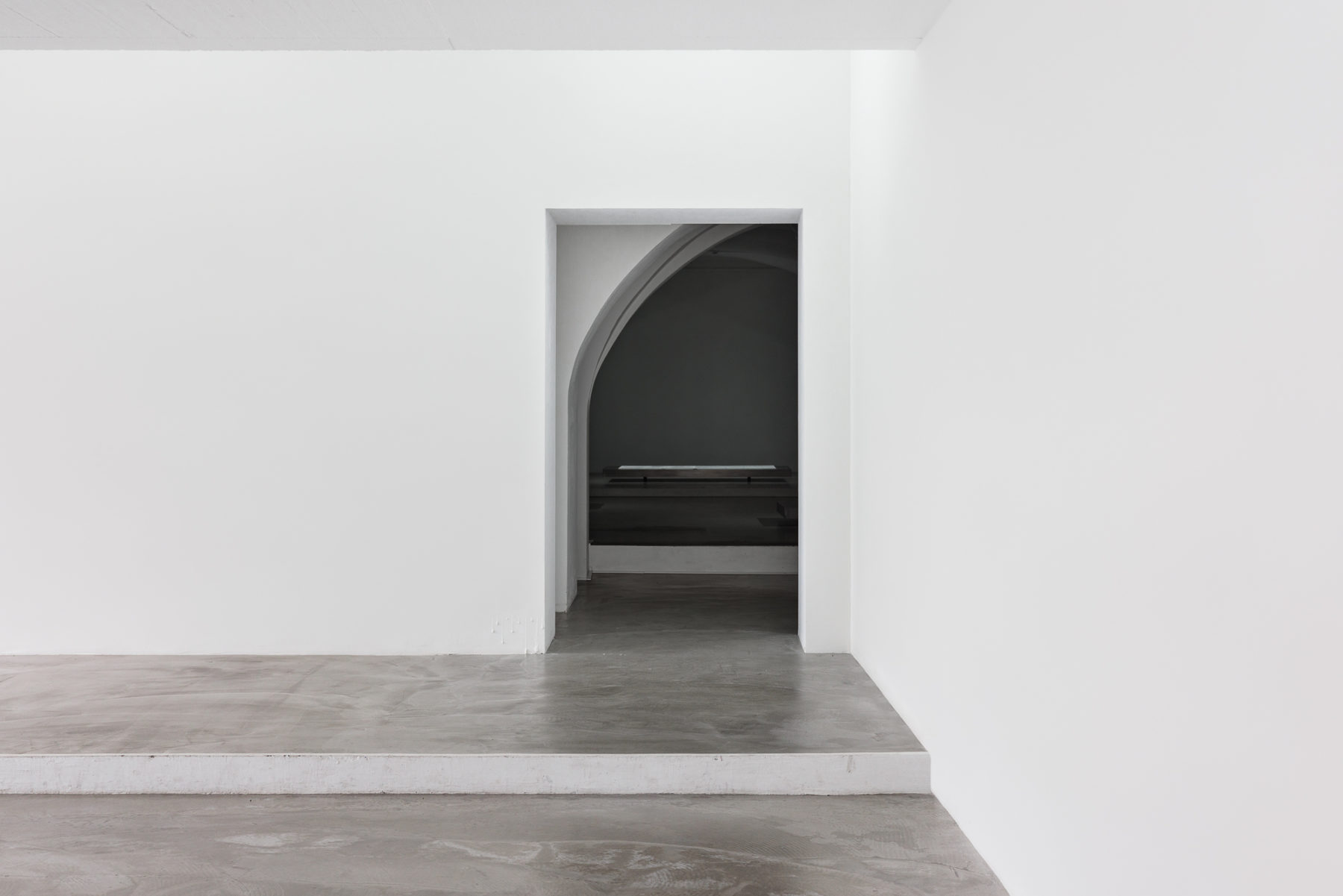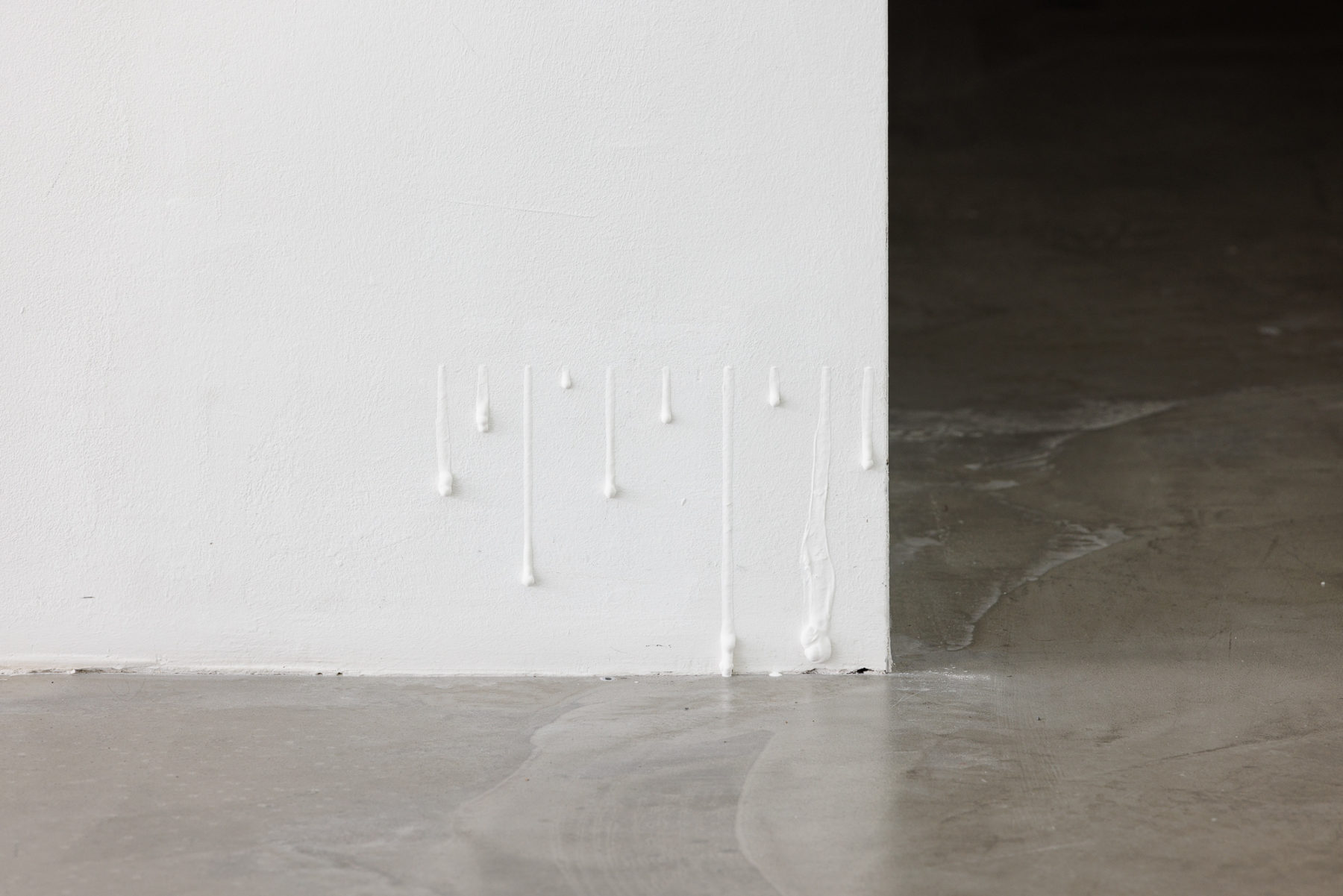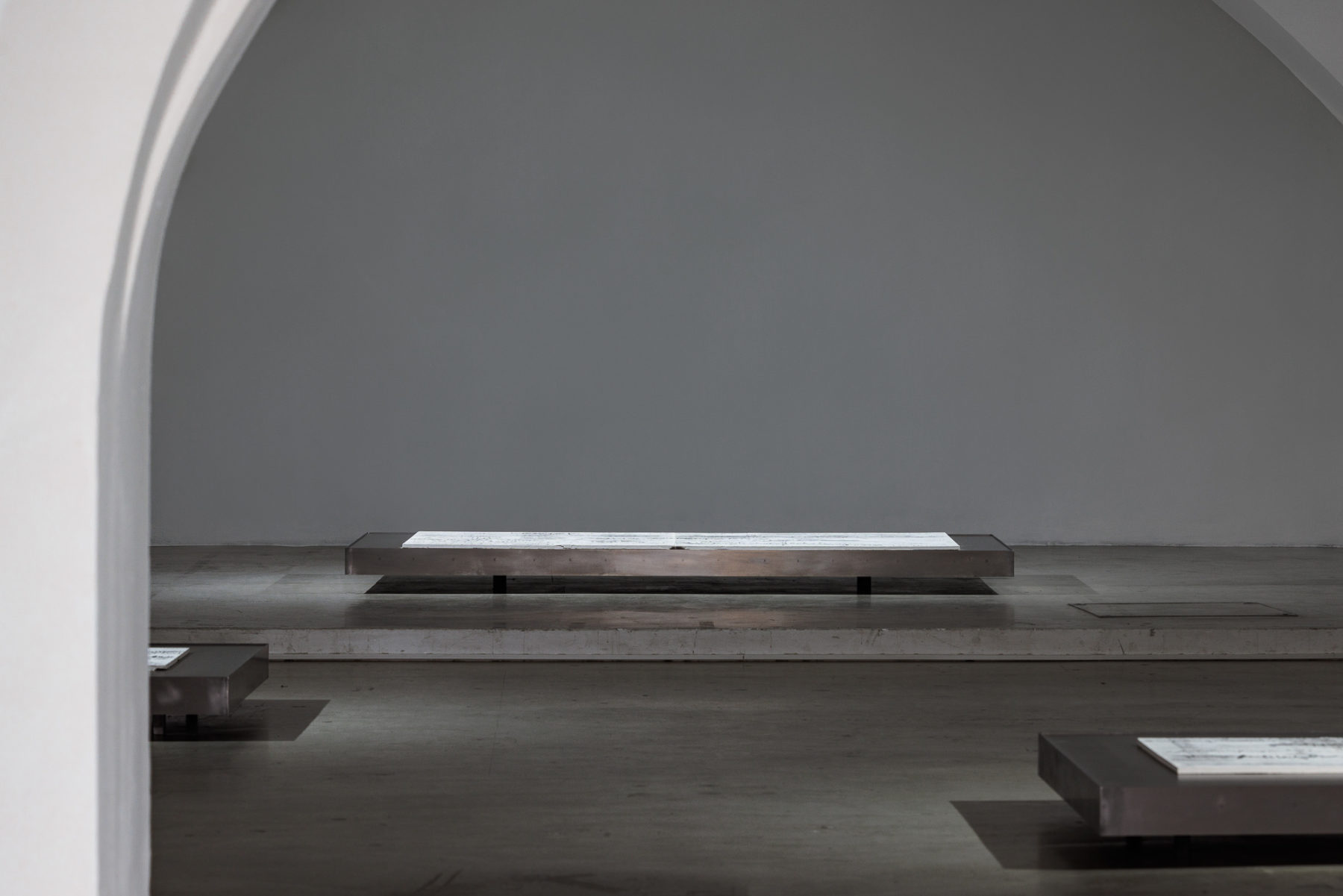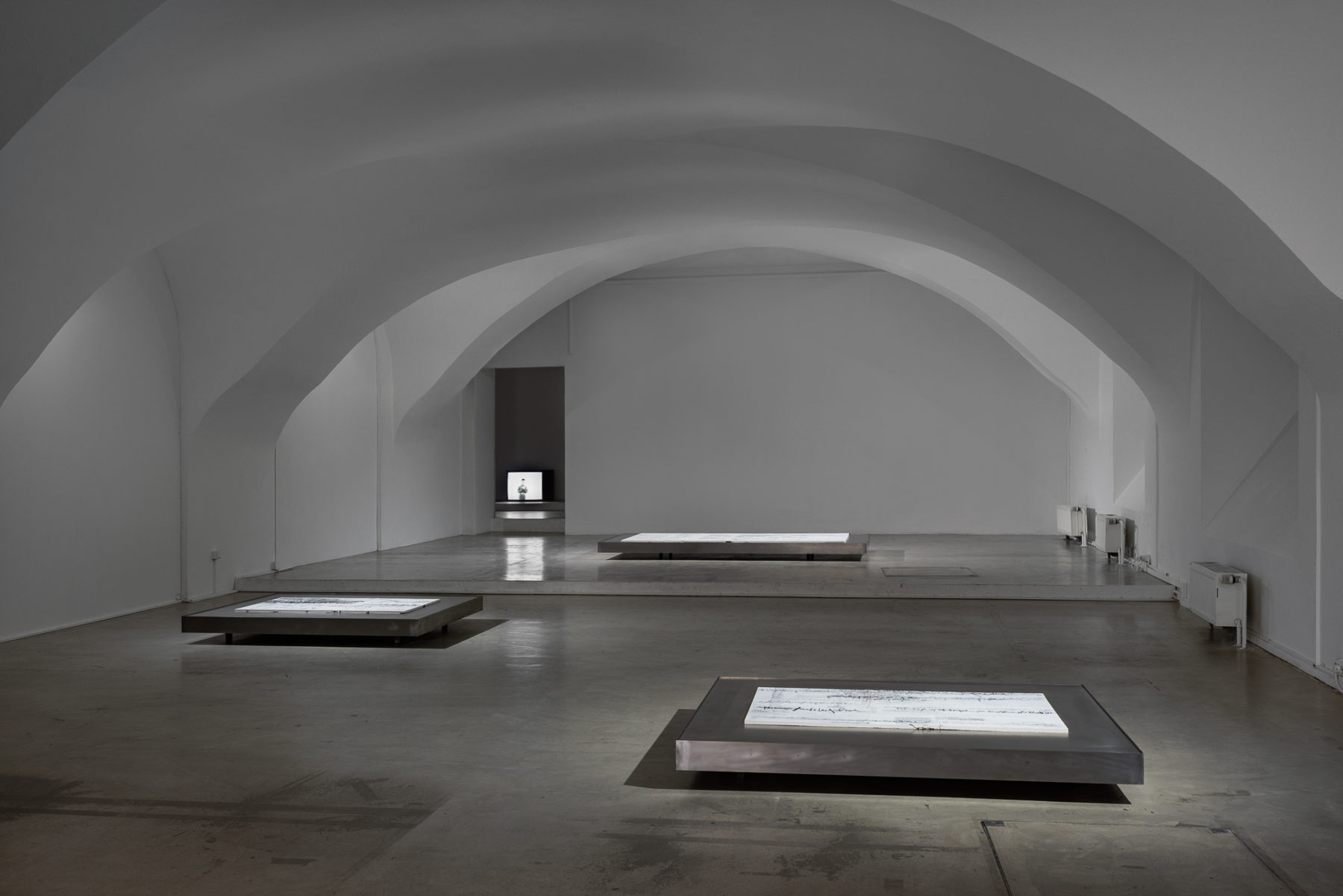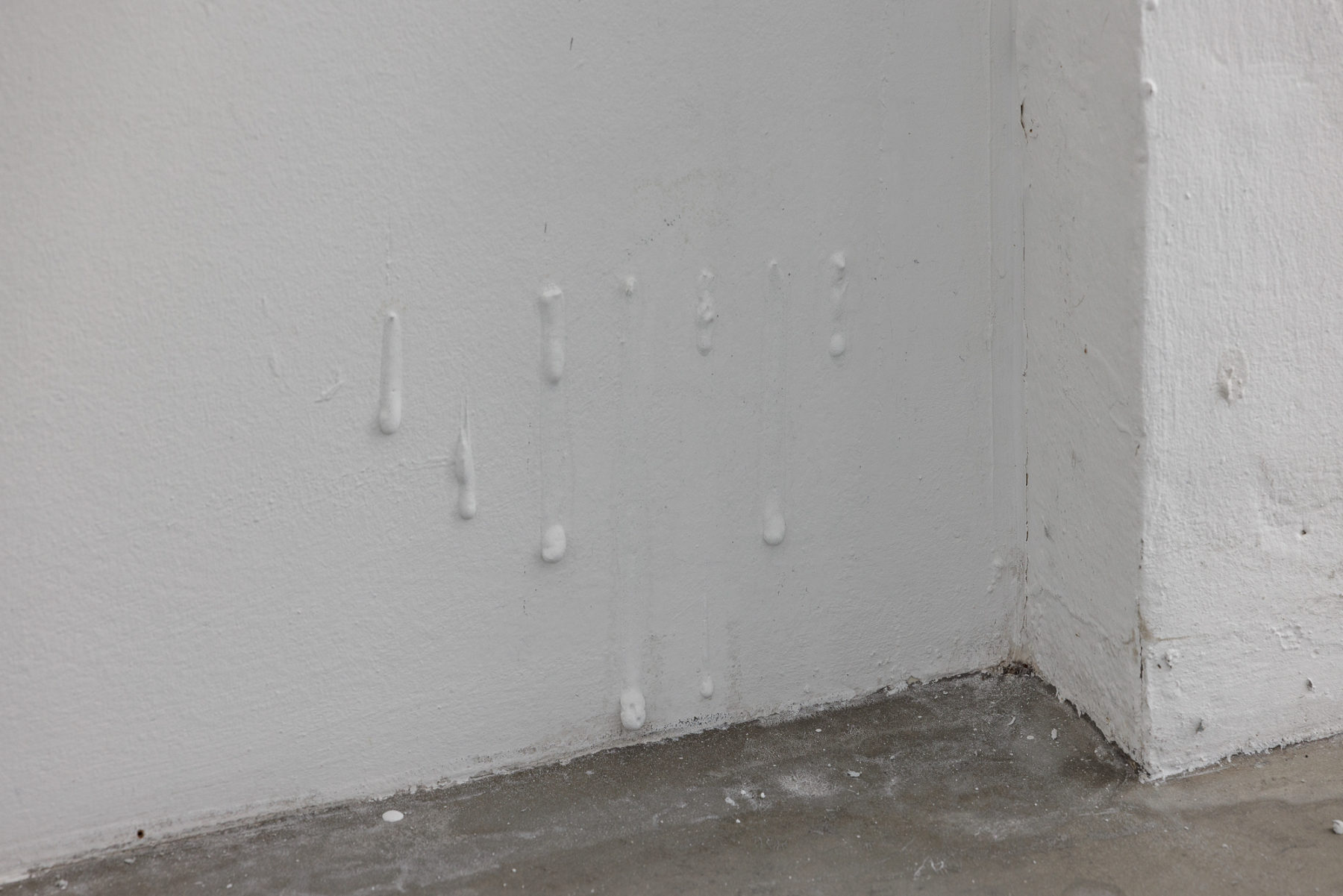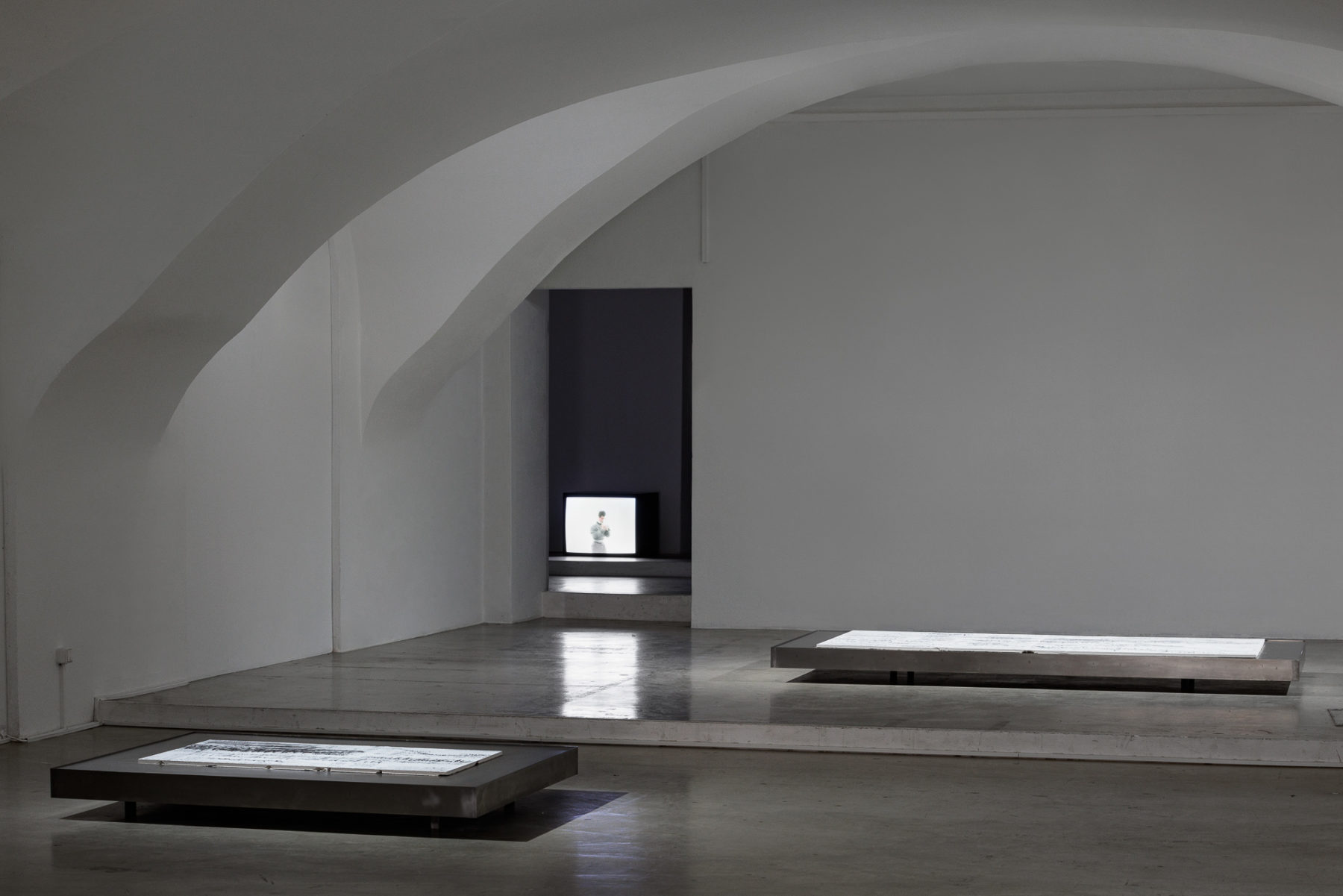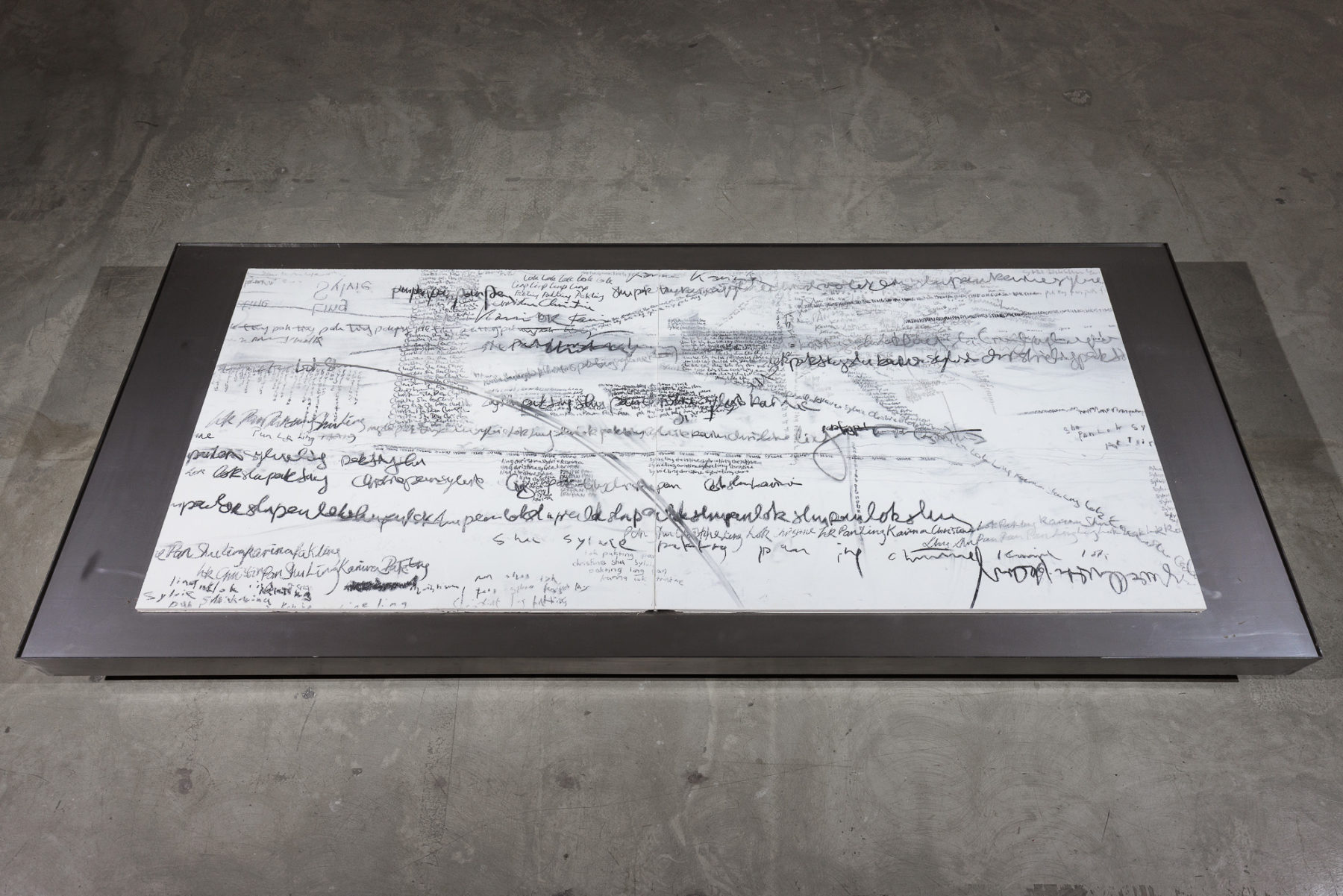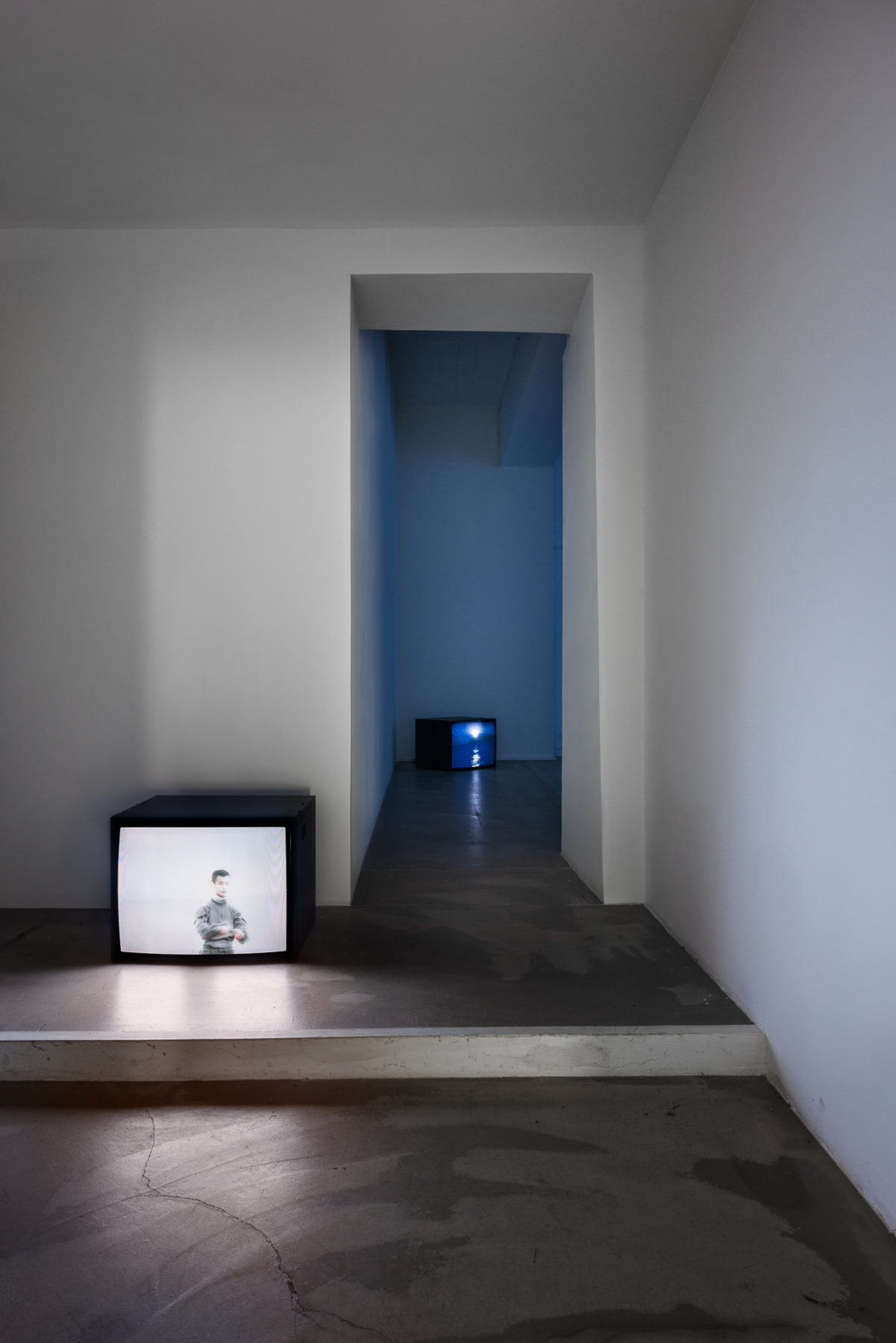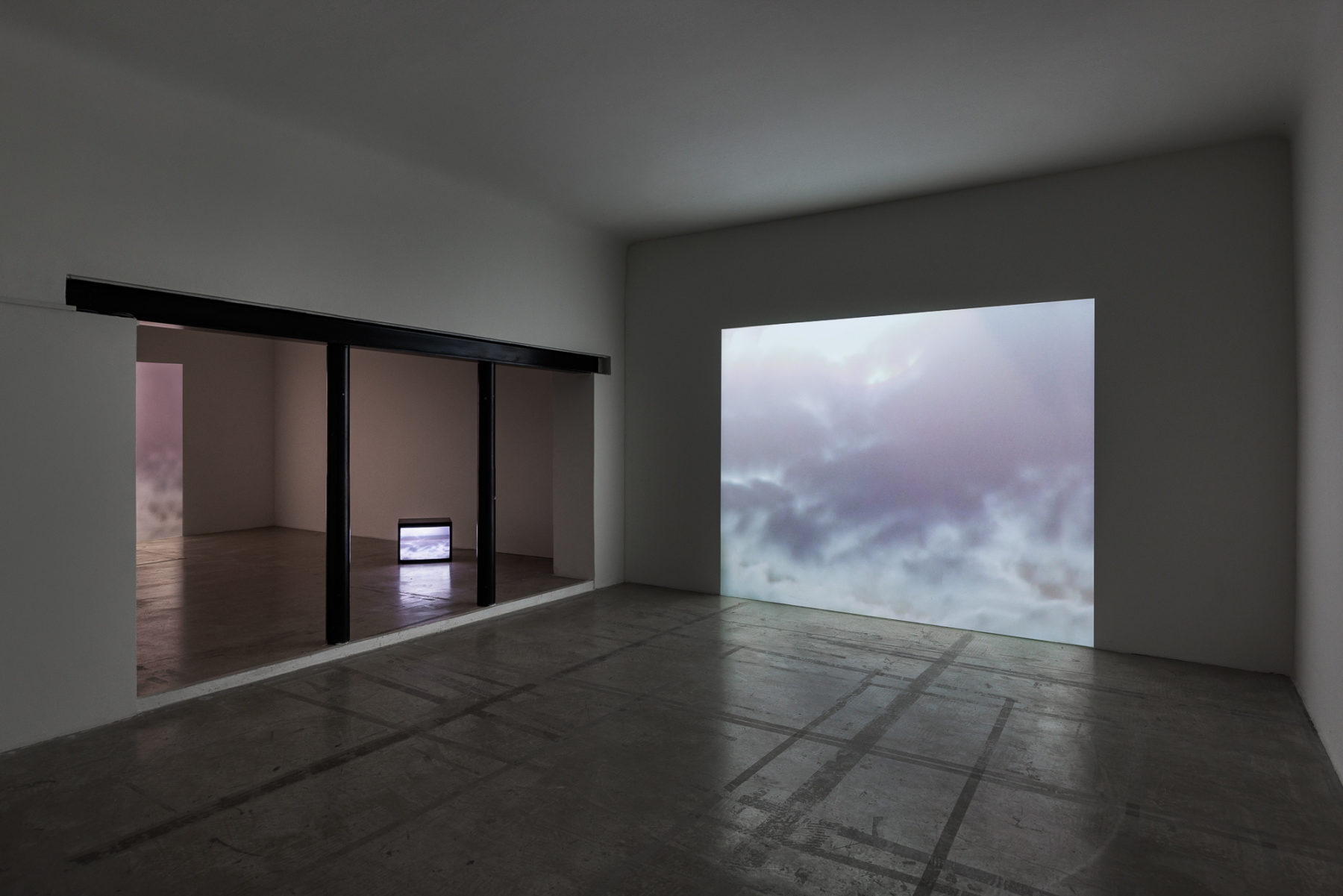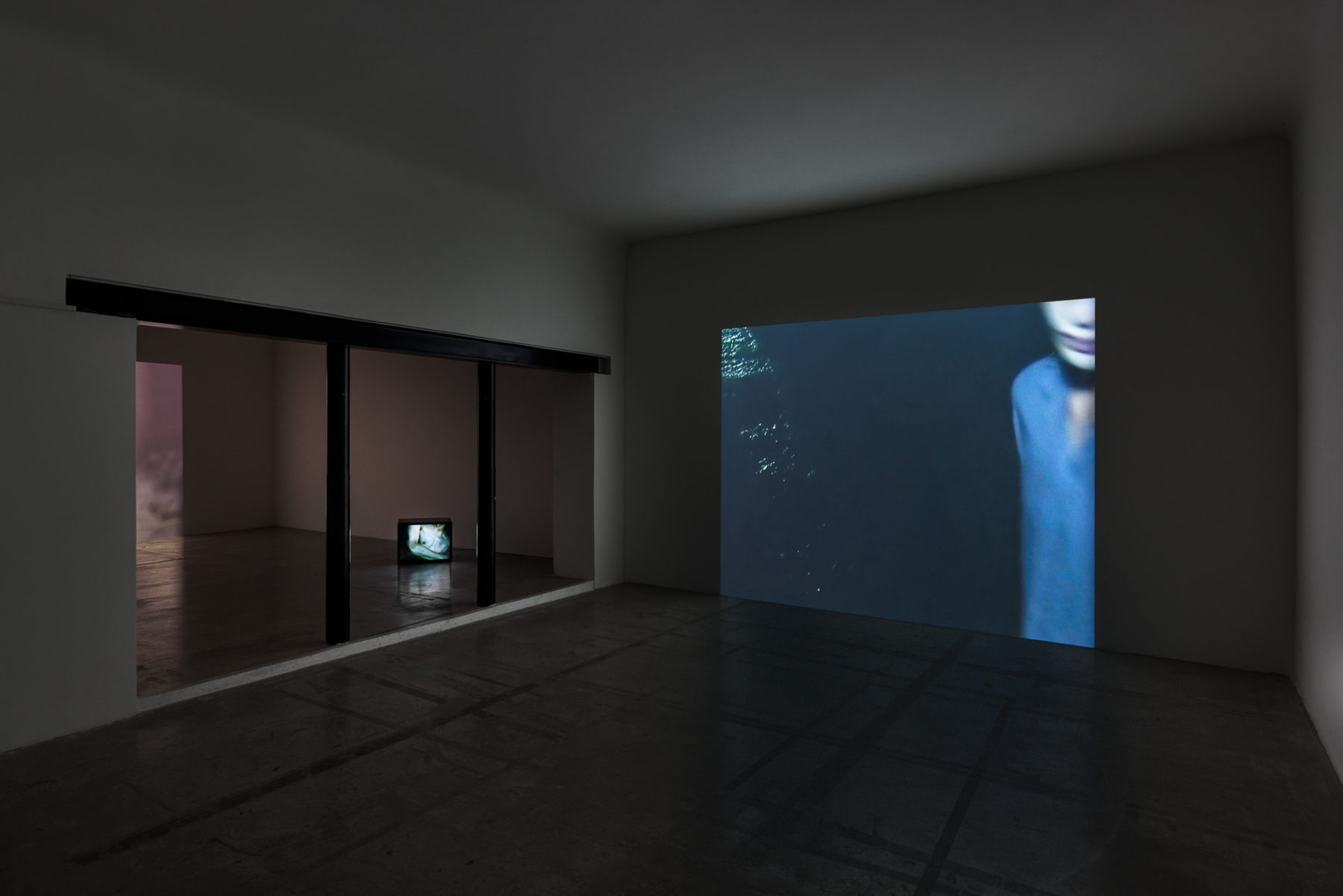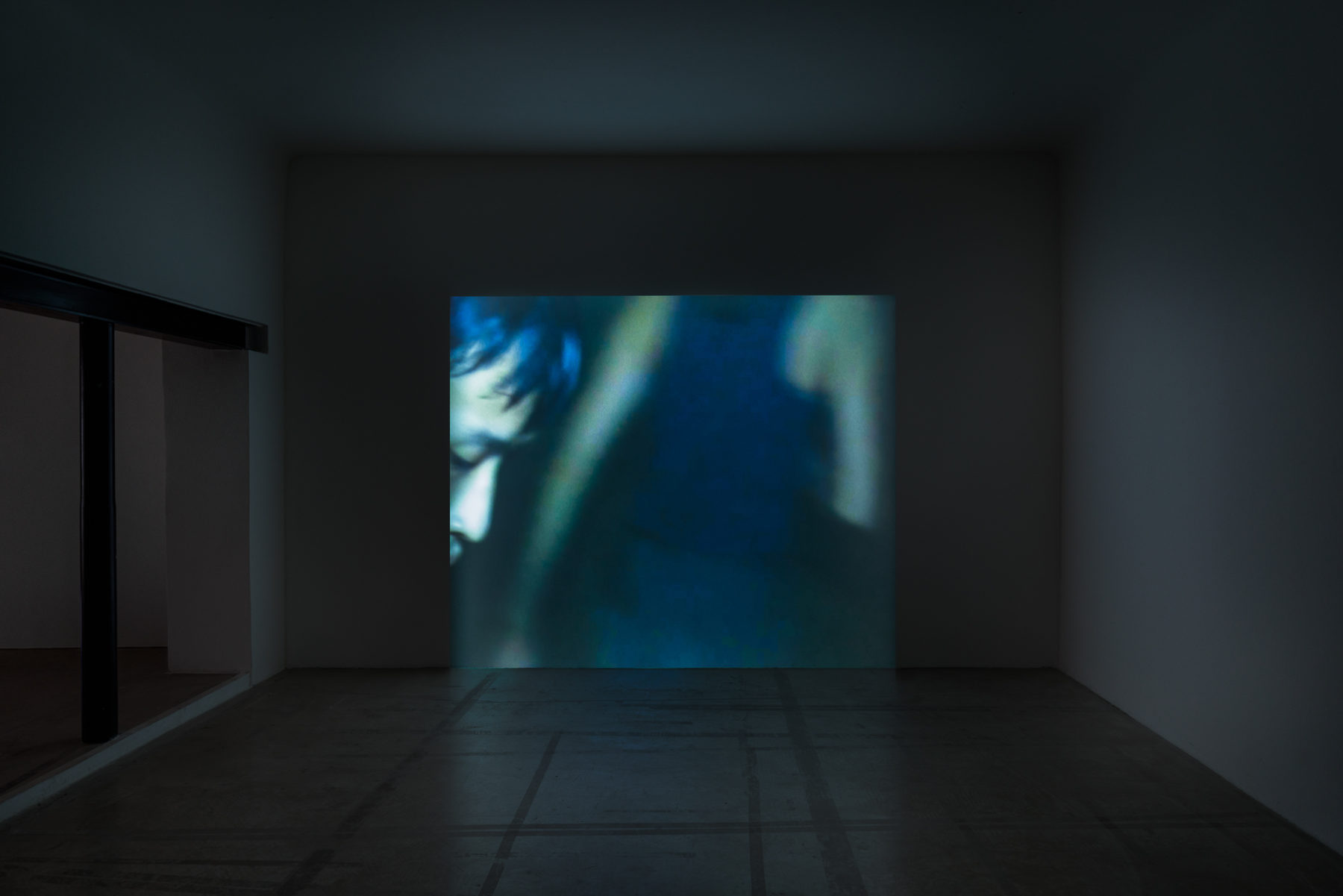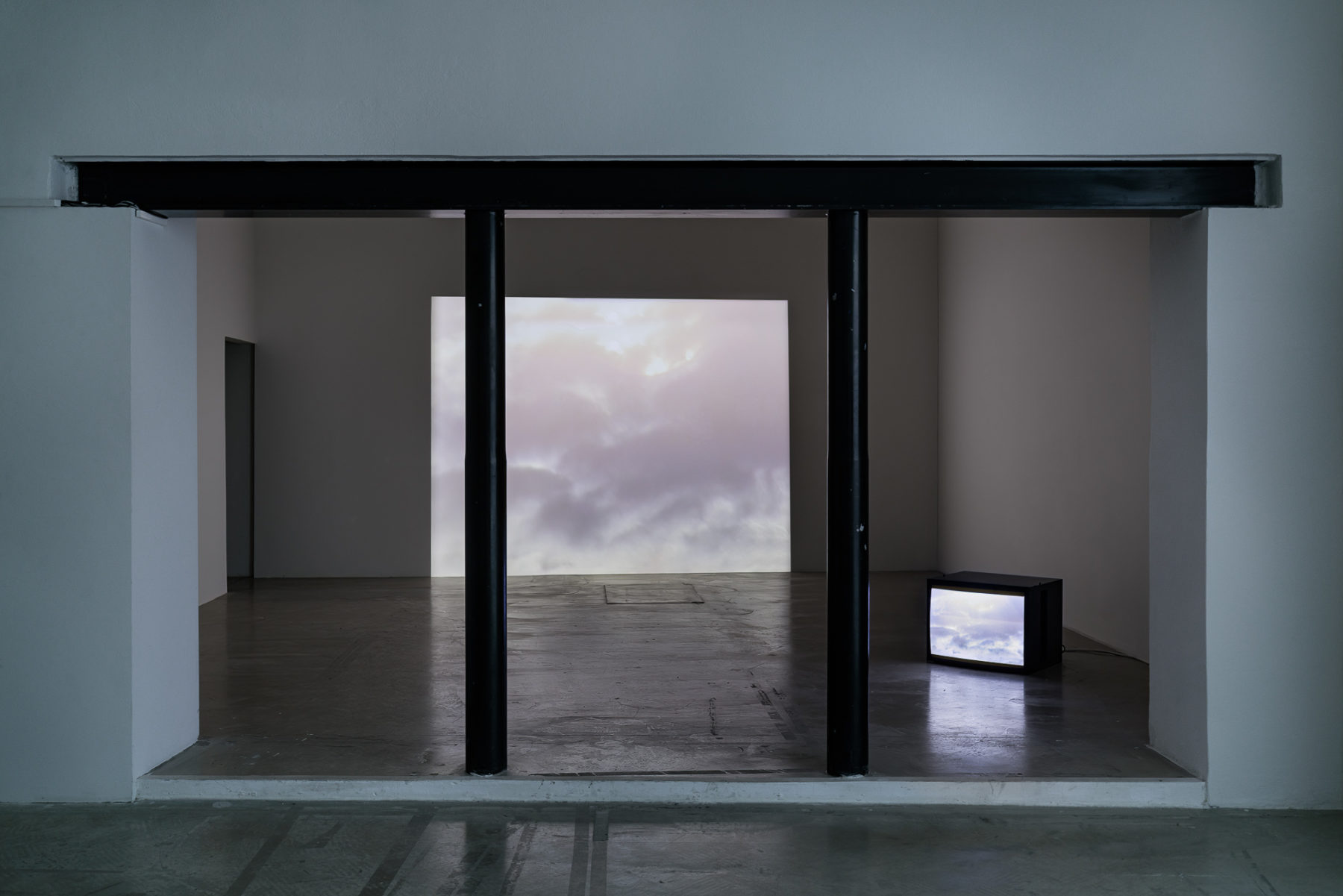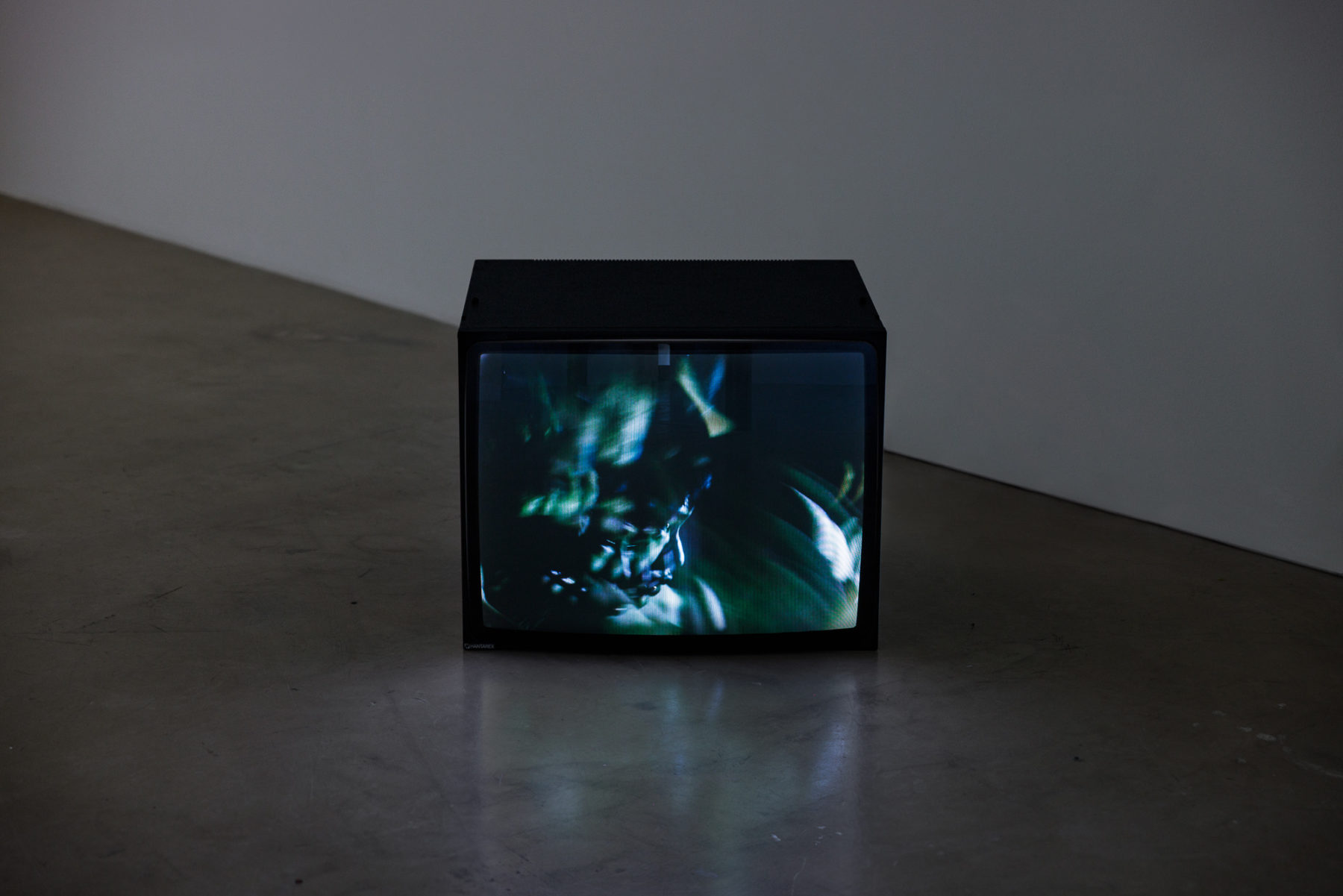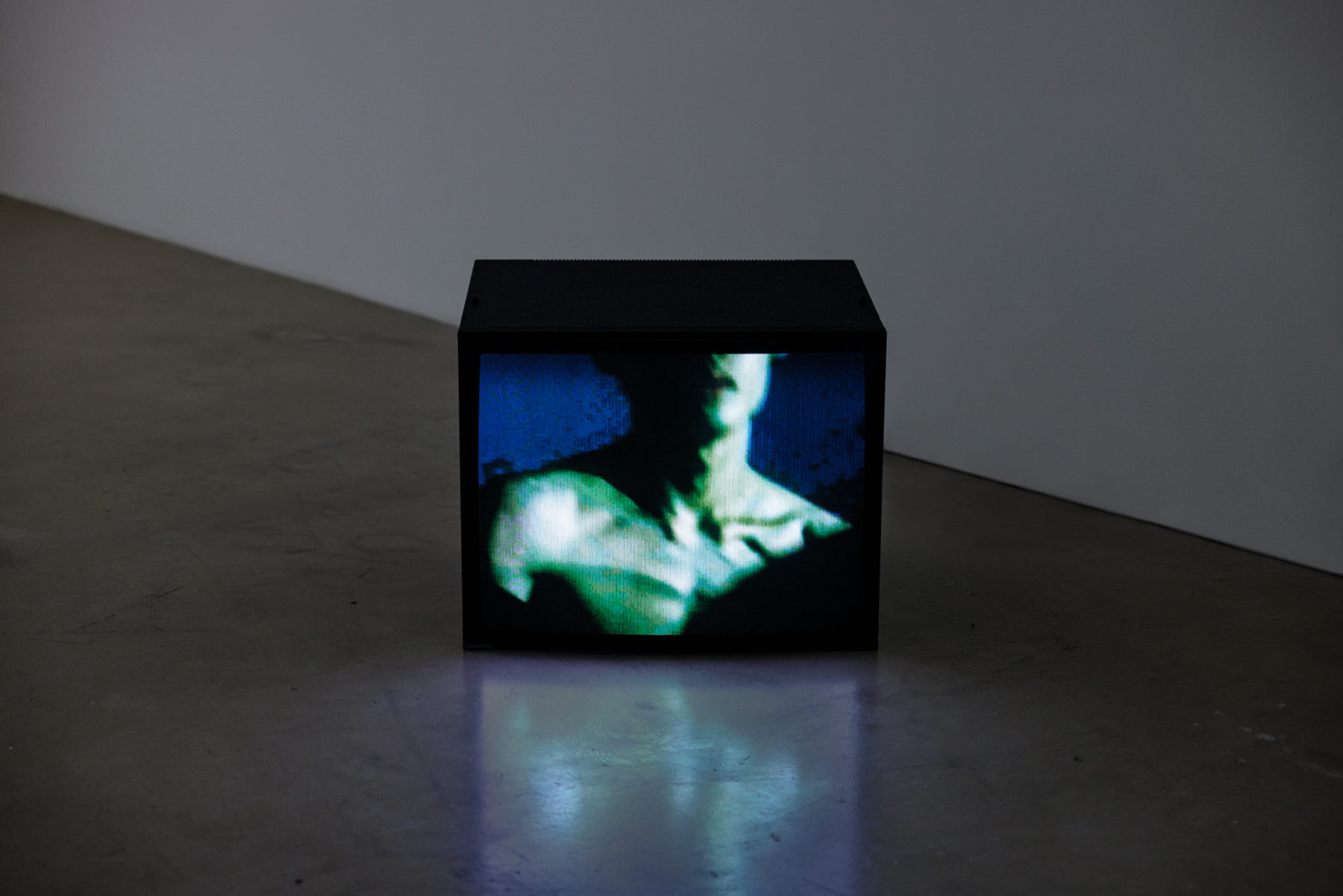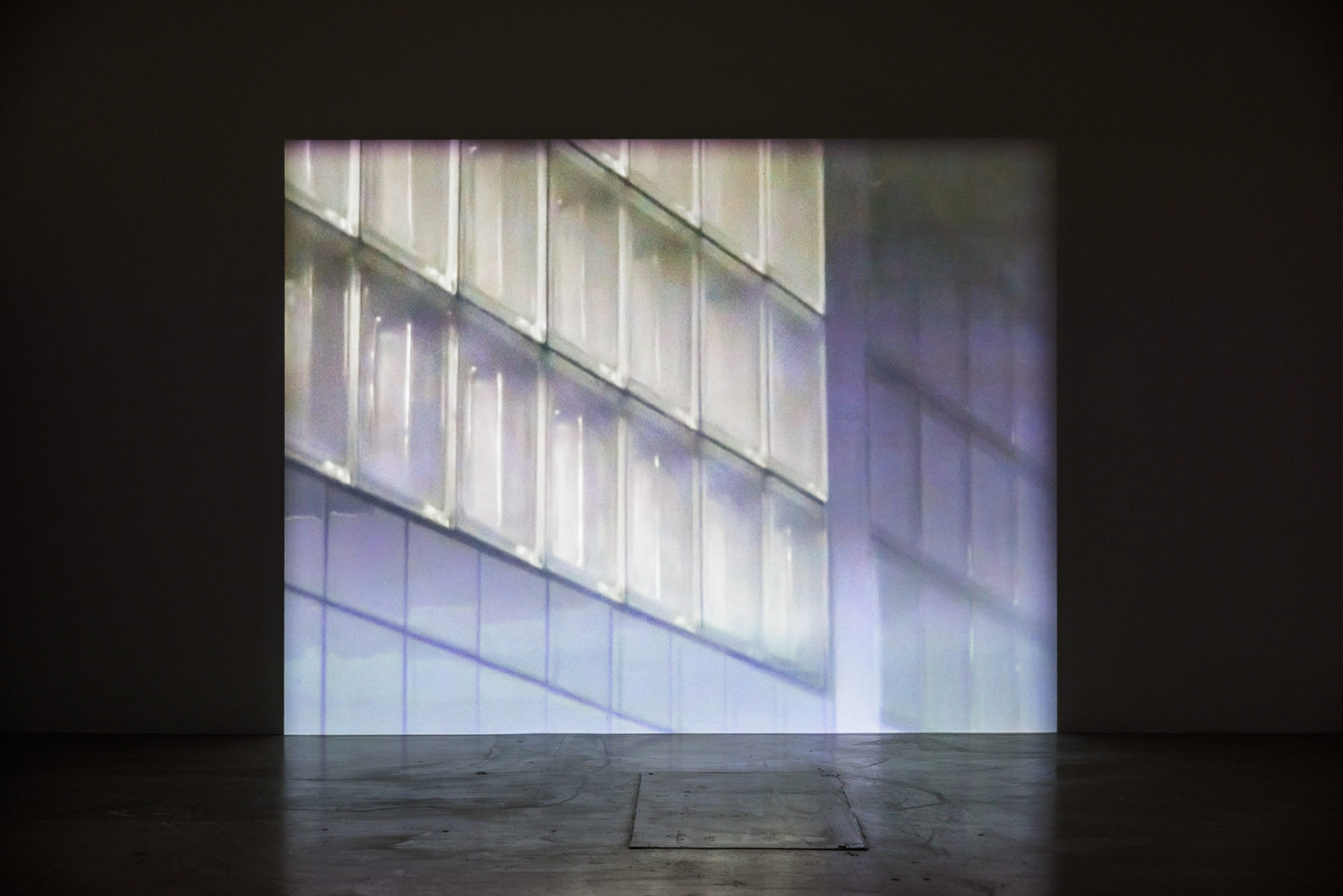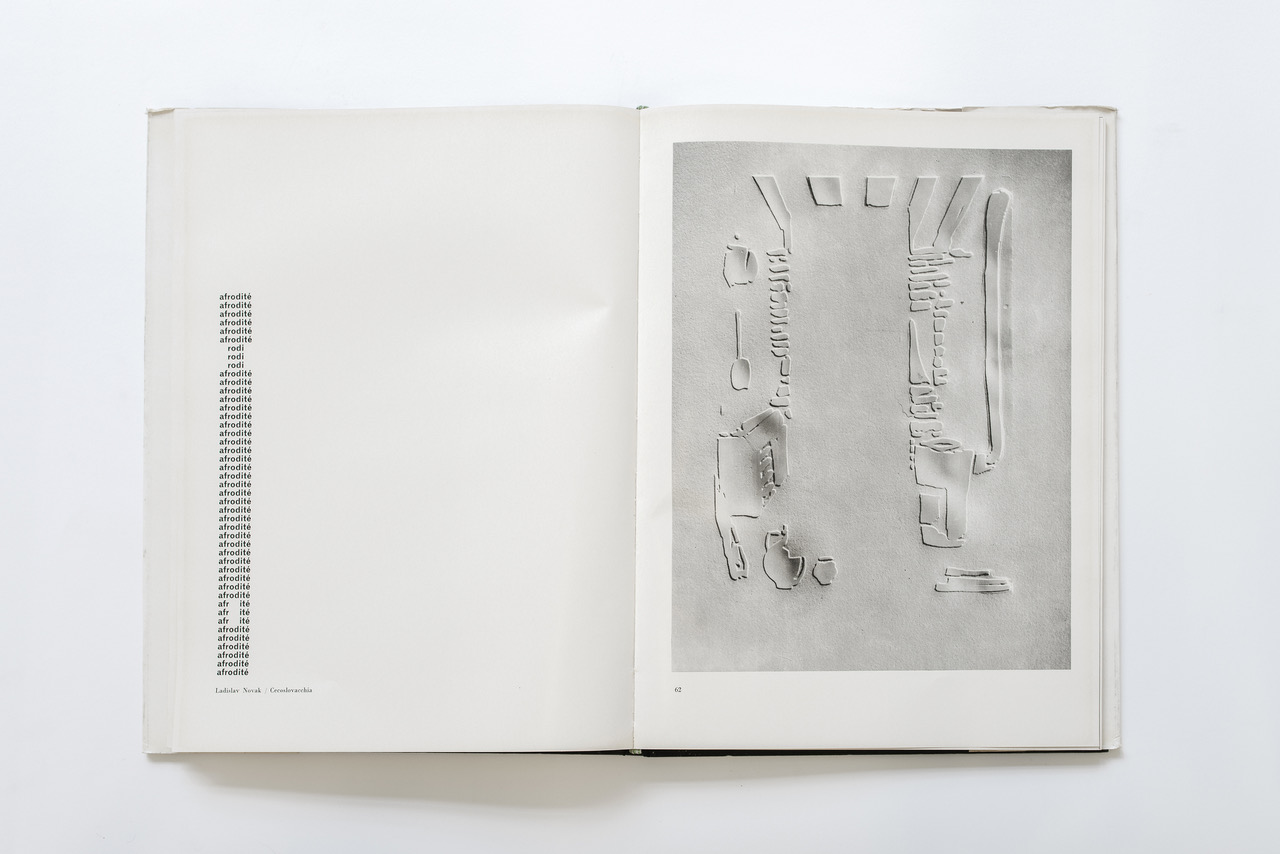
This publication coincides with the exhibition The Weight of the Concrete by Ezio Gribaudo in a scenography by Davide Stucchi. It is the seventh entry in a series of compact volumes featuring visual contributions, correspondence, responses, and conversations accompanying the Grazer Kunstverein exhibition program.
This volume contains photographic excerpts from Ezio Gribaudo’s series of achromatic embossed “Logogrifi” limited edition books, created between 1965 and 1972. These works challenge the conventional relationship between ink and material in print, using embossing to highlight the tangible process of creating printed matter. One of the key elements of Gribaudo’s work is the “logogrifo” (logogriph), a word puzzle derived from the Greek “logos” (word) and “griphos” (riddle). Typically, the logogriph, or a riddle in verse, involves altering words by adding, removing, or changing one letter at a time to form other words. In Gribaudo’s interpretation, a logogrifo oscillates between legibility and abstraction, serving both as readable forms and as a gateway to an enigmatic world where the image and language, disconnected from their origins, coalesce. This publication, The Weight of the Concrete, features a selection of pages from the “Logogrifi” books, uniquely complemented by an intervention on the back cover by Davide Stucchi as a conceptual and poetic response to its title.
Editors: Tom Engels, Lilou Vidal
Images: Ezio Gribaudo
Intervention: Davide Stucchi
Graphic Design: Julie Peeters
Photography: Martteo Ninarello, Martina Caravella
Edition: 350
Typeface: Kleisch GK by Chiachi Chao
64 pages, B&W
ISBN: 978-3-9505230-6-5
Price: 9,- euros, 5,- euros for members
Ezio Gribaudo
Logogrifo, ca. 1967-70.
Silk screen print
Edition: 99
50 x 69 cm
Numbered and signed.
€ 600,00* (excl. VAT, excl. packing and shipping costs)
*The editions are available to the members of Grazer Kunstverein. It is possible to become a member when purchasing an edition.
EZIO GRIBAUDO (1929-2022, Italy) was an artist and art publisher based in Turin. Gribaudo’s work, notable for its fusion of figurative, textual, and topographical elements, was shaped by his expertise in typography, industrial printing, and publishing. He managed the Edizione d’Arte Fratelli Pozzo publishing house and was instrumental in the Le Grande Monografie series by Fabbri Editori, producing monographs on artists such as Karel Appel, Francis Bacon, Alberto Burri, Giorgio de Chirico, Marcel Duchamp, Man Ray, Joan Miró, Henry Moore, Antoni Tàpies, among others. In collaboration with Michel Tapié, he contributed to the ICAR (International Center of Aesthetic Research) in 1960. Gribaudo was also committed to curatorial projects, such as the exhibition of the Peggy Guggenheim Collection at Galleria Civica d’Arte Moderna, Turin, in 1976, and Jean Dubuffet’s exhibition-performance CouCou Bazar at Promotrice delle Belle Arti with FIAT in 1978.
Ezio Gribaudo’s artistic trajectory is characterized by a prolific exhibition history. His work has been featured in exhibitions both in Italy and internationally since the late 1950s and continues to be exhibited to this day. A small selection of solo exhibitions includes: Galleria d’Arte La Bussola, Turin (1959); Galleria Schwarz, Milan (1967/1972); Galleria la Bertesca, Genoa (1967); Galleria Viotti, Turin (1968); Galerie de France, Paris (1968); Kunstverein Göttingen (1971); Petit Palais, Musée d’Art Moderne, Geneva (1971); Museum of Modern Art, Rio de Janeiro (1973); Marlborough Graphics Gallery, London (1974); Galleria Michaud, Florence (1975); Etablissement d’en face, Brussels (2019); and Galerie Sans Titre, Paris (2022).
In addition, Gribaudo participated in significant exhibitions such as the 9th Rome Quadriennale (1965); the 33rd Venice Biennale (1966); Salon de Mai, Paris (1967); Salon de Mayo, Havana (1967); the 9th São Paulo Art Biennial (1967); Stedelijk Van Abbemuseum, Eindhoven (1967); GAM (Galleria Civica d’Arte Moderna), Turin (1967); Salon de Mai, Paris (1968); Museum of Modern Art, Caracas (1968); The National Gallery, Prague (1969); the 8th International Exhibition of Graphic Arts, Ljubljana (1969); the 10th Rome Quadriennale (1973); Fundação Calouste Gulbenkian, Lisbon (1979); International Exhibition of Graphic Arts, Bilbao (1982); Grand Palais, Paris (1982); Castello di Rivoli, Rivoli (1986); the Italian Pavilion at the 54th Venice Biennale (2011); Sandretto Re Rebaudengo Foundation, Turin (2015); Peggy Guggenheim Collection, Venice (2016); Museo del Novecento, Milan (2017); GAM (Galleria Civica d’Arte Moderna), Turin (2017); Pio Pico Gallery, Los Angeles (2020); and MACRO Museum of Contemporary Art of Rome (2021).
Ezio Gribaudo
Logogrifo, ca. 1967-70.
Silk screen print
Edition: 99
69 x 50 cm
Numbered and signed.
€ 600,00* (excl. VAT, excl. packing and shipping costs)
*The editions are available to the members of Grazer Kunstverein. It is possible to become a member when purchasing an edition.
EZIO GRIBAUDO (1929-2022, Italy) was an artist and art publisher based in Turin. Gribaudo’s work, notable for its fusion of figurative, textual, and topographical elements, was shaped by his expertise in typography, industrial printing, and publishing. He managed the Edizione d’Arte Fratelli Pozzo publishing house and was instrumental in the Le Grande Monografie series by Fabbri Editori, producing monographs on artists such as Karel Appel, Francis Bacon, Alberto Burri, Giorgio de Chirico, Marcel Duchamp, Man Ray, Joan Miró, Henry Moore, Antoni Tàpies, among others. In collaboration with Michel Tapié, he contributed to the ICAR (International Center of Aesthetic Research) in 1960. Gribaudo was also committed to curatorial projects, such as the exhibition of the Peggy Guggenheim Collection at Galleria Civica d’Arte Moderna, Turin, in 1976, and Jean Dubuffet’s exhibition-performance CouCou Bazar at Promotrice delle Belle Arti with FIAT in 1978.
Ezio Gribaudo’s artistic trajectory is characterized by a prolific exhibition history. His work has been featured in exhibitions both in Italy and internationally since the late 1950s and continues to be exhibited to this day. A small selection of solo exhibitions includes: Galleria d’Arte La Bussola, Turin (1959); Galleria Schwarz, Milan (1967/1972); Galleria la Bertesca, Genoa (1967); Galleria Viotti, Turin (1968); Galerie de France, Paris (1968); Kunstverein Göttingen (1971); Petit Palais, Musée d’Art Moderne, Geneva (1971); Museum of Modern Art, Rio de Janeiro (1973); Marlborough Graphics Gallery, London (1974); Galleria Michaud, Florence (1975); Etablissement d’en face, Brussels (2019); and Galerie Sans Titre, Paris (2022).
In addition, Gribaudo participated in significant exhibitions such as the 9th Rome Quadriennale (1965); the 33rd Venice Biennale (1966); Salon de Mai, Paris (1967); Salon de Mayo, Havana (1967); the 9th São Paulo Art Biennial (1967); Stedelijk Van Abbemuseum, Eindhoven (1967); GAM (Galleria Civica d’Arte Moderna), Turin (1967); Salon de Mai, Paris (1968); Museum of Modern Art, Caracas (1968); The National Gallery, Prague (1969); the 8th International Exhibition of Graphic Arts, Ljubljana (1969); the 10th Rome Quadriennale (1973); Fundação Calouste Gulbenkian, Lisbon (1979); International Exhibition of Graphic Arts, Bilbao (1982); Grand Palais, Paris (1982); Castello di Rivoli, Rivoli (1986); the Italian Pavilion at the 54th Venice Biennale (2011); Sandretto Re Rebaudengo Foundation, Turin (2015); Peggy Guggenheim Collection, Venice (2016); Museo del Novecento, Milan (2017); GAM (Galleria Civica d’Arte Moderna), Turin (2017); Pio Pico Gallery, Los Angeles (2020); and MACRO Museum of Contemporary Art of Rome (2021).
The Weight of the Tongue is a sound program that is presented in the framework of The Weight of the Concrete by Ezio Gribaudo. It explores the vocalization of experimental and concrete poetry. The program gathers the voices of Katalin Ladik, Tomaso Binga, CAConrad, Susan Howe and David Grubbs, Nadia Marcus, Bryana Fritz, Hanne Lippard, and Patrizia Vicinelli. Their contributions will be accessible throughout the exhibition.
The program serves as a speculative prelude to an upcoming publication The Weight of the Concrete (2024), which reflects the editorial premise of Il Peso del Concreto (1968), that featured Gribaudo’s early graphic work alongside an anthology of concrete poetry edited by the poet Adriano Spatola. The 2024 publication revisits and reimagines this publication and the archive of its making, pairing Gribaudo’s graphic work with a new selection of historic and contemporary concrete and experimental poetry.
Katalin Ladik, Nadia Marcus and Bryana Fritz will perform their contributions at the opening of The Weight of the Concrete on December 7, 2023, at 19:00.
Susan Howe and David Grubbs, Six Pages from Concordance, 2022. 01:00:00
Katalin Ladik, Lullaby, 1977, recorded in 2016. 02:11
Katalin Ladik, Psalm, 1977, recorded in 2016. 01:08
Katalin Ladik, Song for oiled stove tube and female voice, 1977, recorded in 2016. 01:29
CAConrad, LLTGBR 1, 2023. 00:33
CAConrad, LLTGBR 2, 2023. 00:37
Bryana Fritz, Lingua Ignota, 2023. 6:32
Tomaso Binga, SognOgnor, 1999. 3:25
Nadia Marcus, Let Me Roll It, 2023. 4:37
Patrizia Vicinelli, Poesia fonetica da Fondamenti dell’essere, 1985-87, recorded at Radio Città del Capo, Bologna, 1988. 01:12
Hanne Lippard, Work, 2020. 01:10
Susan Howe (b. 1937, United States) and David Grubbs (b. 1967, United States) have been collaborating since 2003. From their latest album collaboration, Concordance (Blue Chopsticks, 2021), they created a 60-minute sound installation titled Six Pages from Concordance. This installation was featured at the 2022 group exhibition Drum Listens to Heart, curated by Anthony Huberman, at the CCA Wattis Institute for Contemporary Arts in San Francisco.
Susan Howe is an American artist, poet, and writer. Howe’s poetry evolved from her painting and drawing career. Closely associated with the late 1970s and 1980s Language Poets’ movement, Susan Howe’s poetry and scholarship are most accurately characterized as language-based and experimental. She is the author of several poetry collections, including Concordance (Paperback, 2020), Debths (New Directions, 2017), That This (New Directions, 2010) among many others. She is also the author of The Gorgeous Nothings ―Emily Dickinson (New Directions, 2013) and books of criticism such as The Birth-Mark: Unsettling the Wilderness in American Literary History (1993) and My Emily Dickinson (New Directions, 1985).
David Grubbs is known for his cross-disciplinary collaborations with poet Susan Howe, visual artists Anthony McCall and Angela Bulloch, and choreographer Jonah Bokaer. His work has been presented at, among other venues, the Solomon R. Guggenheim Museum, MoMA, the Tate Modern, and the Centre Pompidou. Grubbs was a member of the groups Gastr del Sol, Bastro, and Squirrel Bait, and has performed with the Red Krayola, Will Old- ham, Tony Conrad, Pauline Oliveros, and Loren Connors, and many others. He is a grant recipient from the Foundation for Contemporary Arts, a contributing editor in music for BOMB Magazine, a member of the Blank Forms board of directors, and director of the Blue Chopsticks record label.
Katalin Ladik (b. 1942, Serbia) lives and works in Budapest. From her background in poetry and theater in the early 1960s to the present day, Ladik has employed multiple formats in her work such as performance, sound art, collage, drawing mail art and photography, while also often drawing on the multicultural and multi-ethnic environments of her native Eastern Europe. Yet throughout this broad range of artistic expression, Ladik’s work is at all times grounded in poetry, whether poetry as text, or poetry in a more expanded sense, such as concrete and visual poetry, musical poetry and poetic performance. Her most recent exhibition, Ooooooooo-pus, is a retrospective collaboratively organized by Haus der Kunst in Munich (2023), Ludwig Forum in Aachen (2023), and the Moderna Museet in Stockholm (2024).
CAConrad (b. 1966, United States) has worked with the ancient technologies of poetry and ritual since 1975. Their latest book is Listen to the Golden Boomerang Return (Wave Books / UK Penguin 2024). They received the Ruth Lily Poetry Prize, a PEN Josephine Miles Award, a Creative Capital grant, a Pew Fellowship, and a Lambda Award. They exhibit poems as art objects with recent solo shows in Spain and Portugal, and their play The Obituary Show was made into a film in 2022 by the artist Augusto Cascales.
Bryana Fritz (b. 1989, United States) is a choreographer, dancer, and writer. She works at the intersection between poetry and performance often in duet with the user interface of OS X. Her work is fed by a continued interest in medieval literature, fanfiction, media studies, and histories of illiteracy. She also collaborates with Henry Andersen under the moniker Slow Reading Club. As a performer, Fritz worked with Anne Teresa de Keersmaeker, Xavier le Roy, Boris Charmatz, Michiel Vandevelde, and Femke Gyselinck.
Tomaso Binga (b. 1931, Italy) has been a vital figure in Rome’s avant-garde art community since 1970. Tomaso Binga—a pseudonym chosen to critique gender-based cultural privileges—has been developing her work across performance, collage, video art, sonic poetry, and painting. Her work distinctively merges various elements – from writing to gestures and images – often exploring the boundaries of meaning. She has participated in exhibitions such as the Venice Biennale, São Paulo Biennial, Festival International d’Art Vivant in Lyon, Quadriennale of Rome, and the J. Klemm Foundation in Buenos Aires. In 2024, she will have a solo exhibition at the Museo Madre, Naples. Recently, she has also participated in exhibitions at La Galerie Centre d’Art Contemporain, Noisy le Sec (2023); Mimosa House, London (2019); La Galleria Nazionale, Rome (2017); Accademia d’Ungheria e Casa delle Letterature, Rome; Sala Santa Rita, Rome (2014); Museo Madre, Naples (2013); and Palazzo delle Esposizioni, Rome (2013).
Nadia Marcus (b. 1993, United States) is a poet, designer, DJ, and co-editor of TABLOID Press, a publishing house and media imprint founded in Berlin in 2014. Her poetry, art criticism, and lyric journalism have recently appeared in Arts of the Working Class, The Ransom Note, and Edit. Marcus has participated in poetry readings and performances in venues such as KW Institute for Contemporary Art (Berlin), Haus am Waldsee (Berlin), and Ny Carlsberg Glyptotek (Copenhagen). In the last years, she has also exhibited at SYSTEMA (Marseille), Kunstverein München (Munich), Mint (Stockholm), and Felix Gaudlitz (Vienna). She holds a residency at the Berlin-based radio station Refuge Worldwide, and as a vocalist has collaborated with Ulla Straus, exael, Perila, and Soho Rezanejad. Aside from the collections of silkscreened clothing Marcus designs and releases under the TABLOID imprint, she has produced graphics for numerous record labels and collectives including Uzuri, West Mineral Ltd., 3XL, Ediciones Capablanca, and Morph.
Patrizia Vicinelli (1943-1991, Italy) played a pivotal role in Italy’s artistic and political activism scenes. As an influential figure in the underground movement, she was an active member of Gruppo 63, a neo-avant-garde literary group. Her engagement with artists and poets such as Emilio Villa, Adriano Spatola, and Aldo Braibanti was a testament to her influential connections. Additionally, Vicinelli’s interactions with figures in the Italian experimental cinema of the 1970s, such as Alberto Grifi and Gianni Castagnoli, underscored her diverse and impactful contributions to the Italian cultural sphere.
Hanne Lippard (b. 1984, United Kingdom) primarily explores the voice as an artistic medium. Her training in graphic design underscores her interest in the visual and social forces of language. More than merely informative, her texts are visual, rhythmic, and performative. Within the lineage of the great figures of feminism, her work interrogates the emancipation and social alienation of the word in our hyper-connected age. She has received the Preis der Nationalgalerie 2024, Hamburger Bahnhof, Berlin (upcoming 2024). Her most recent performances and exhibitions include The Myths and Realities of Achieving Financial Independence, CCA Berlin – Center for Contemporary Arts, Berlin (2022); Le langage est une peau, FRAC Lorraine, Metz (2021); Contact, Mood, Share at MHKA, Antwerp (2021); RIBOCA2, Riga (2020); ART 4 ALL, Hamburger Bahnhof, Berlin (2020); and Our present, Museum für Gegenwartskunst, Siegen (2020), amongst others.

The Weight of the Tongue is a sound program that is presented in the framework of The Weight of the Concrete by Ezio Gribaudo. It explores the vocalization of experimental and concrete poetry. The program gathers the voices of Katalin Ladik, Tomaso Binga, CAConrad, Susan Howe and David Grubbs, Nadia Marcus, Bryana Fritz, Hanne Lippard, and Patrizia Vicinelli.
On the occasion of the opening of The Weight of the Concrete, Katalin Ladik, Nadia Marcus, and Bryana Fritz will present live performances of their contributions.
Katalin Ladik (b. 1942, Serbia) lives and works in Budapest. From her background in poetry and theater in the early 1960s to the present day, Ladik has employed multiple formats in her work such as performance, sound art, collage, drawing mail art and photography, while also often drawing on the multicultural and multi-ethnic environments of her native Eastern Europe. Yet throughout this broad range of artistic expression, Ladik’s work is at all times grounded in poetry, whether poetry as text, or poetry in a more expanded sense, such as concrete and visual poetry, musical poetry and poetic performance. Her most recent exhibition, Ooooooooo-pus, is a retrospective collaboratively organized by Haus der Kunst in Munich (2023), Ludwig Forum in Aachen (2023), and the Moderna Museet in Stockholm (2024).
Bryana Fritz (b. 1989, United States) is a choreographer, dancer, and writer. She works at the intersection between poetry and performance often in duet with the user interface of OS X. Her work is fed by a continued interest in medieval literature, fanfiction, media studies, and histories of illiteracy. She also collaborates with Henry Andersen under the moniker Slow Reading Club. As a performer, Fritz worked with Anne Teresa de Keersmaeker, Xavier le Roy, Boris Charmatz, Michiel Vandevelde, and Femke Gyselinck.
Nadia Marcus (b. 1993, United States) is a poet, designer, DJ, and co-editor of TABLOID Press, a publishing house and media imprint founded in Berlin in 2014. Her poetry, art criticism, and lyric journalism have recently appeared in Arts of the Working Class, The Ransom Note, and Edit. Marcus has participated in poetry readings and performances in venues such as KW Institute for Contemporary Art (Berlin), Haus am Waldsee (Berlin), and Ny Carlsberg Glyptotek (Copenhagen). In the last years, she has also exhibited at SYSTEMA (Marseille), Kunstverein München (Munich), Mint (Stockholm), and Felix Gaudlitz (Vienna). She holds a residency at the Berlin-based radio station Refuge Worldwide, and as a vocalist has collaborated with Ulla Straus, exael, Perila, and Soho Rezanejad. Aside from the collections of silkscreened clothing Marcus designs and releases under the TABLOID imprint, she has produced graphics for numerous record labels and collectives including Uzuri, West Mineral Ltd., 3XL, Ediciones Capablanca, and Morph.
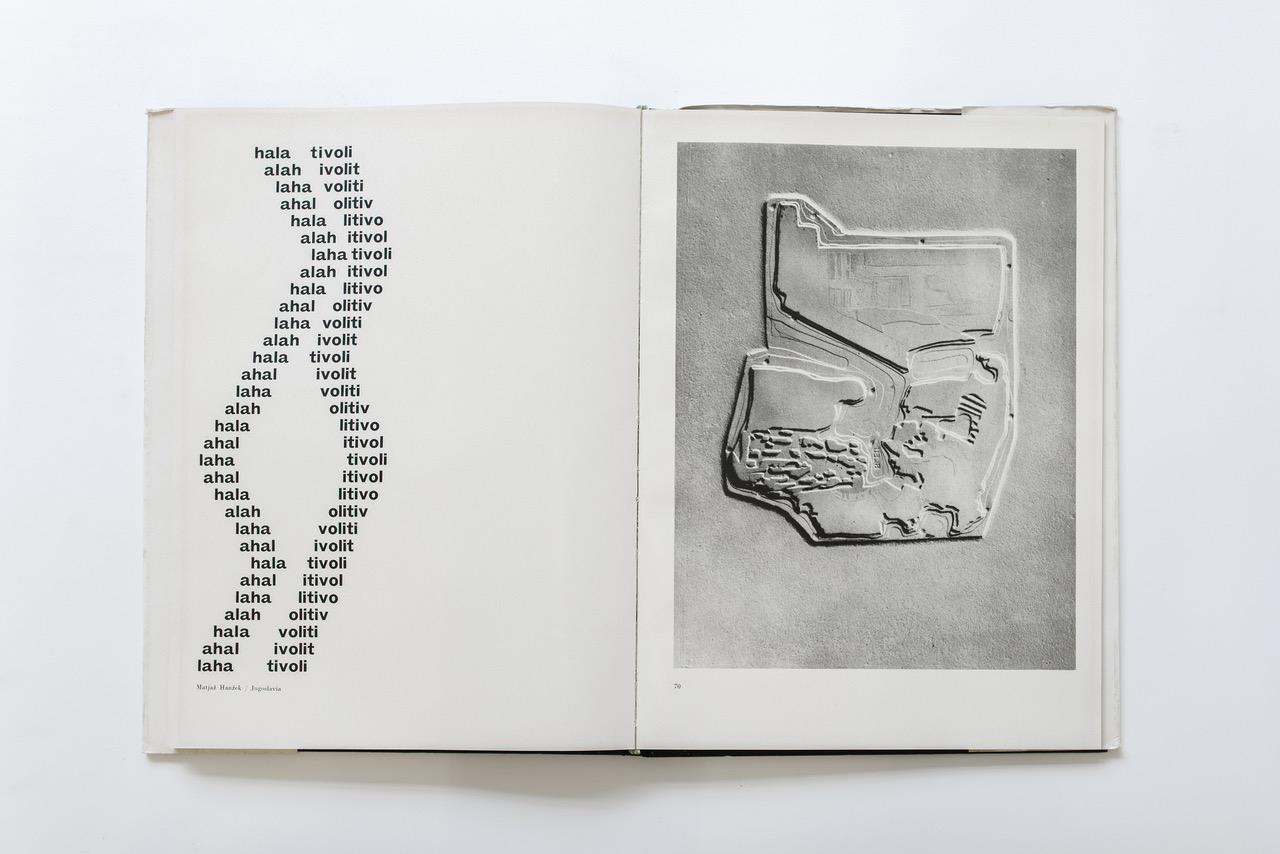
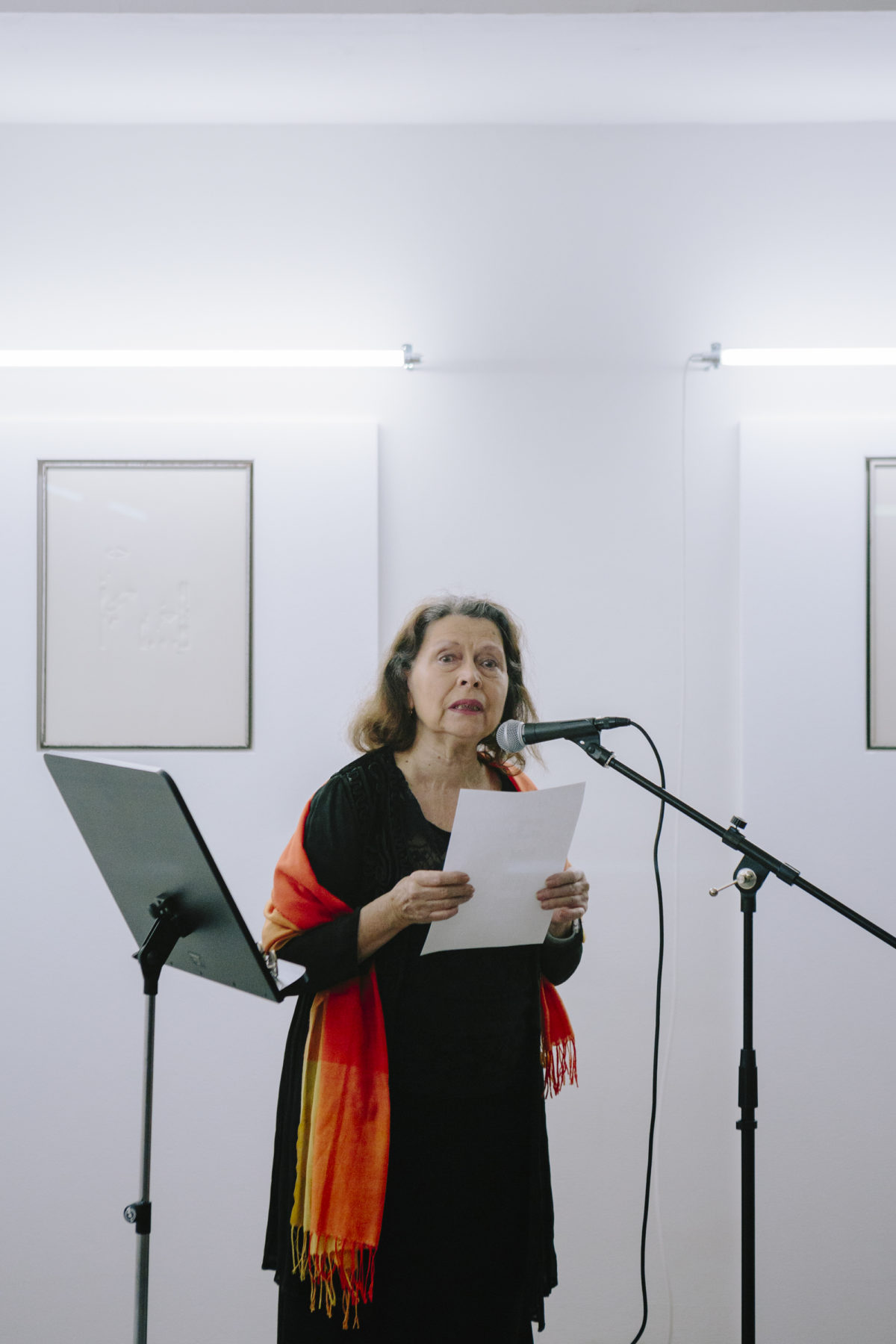
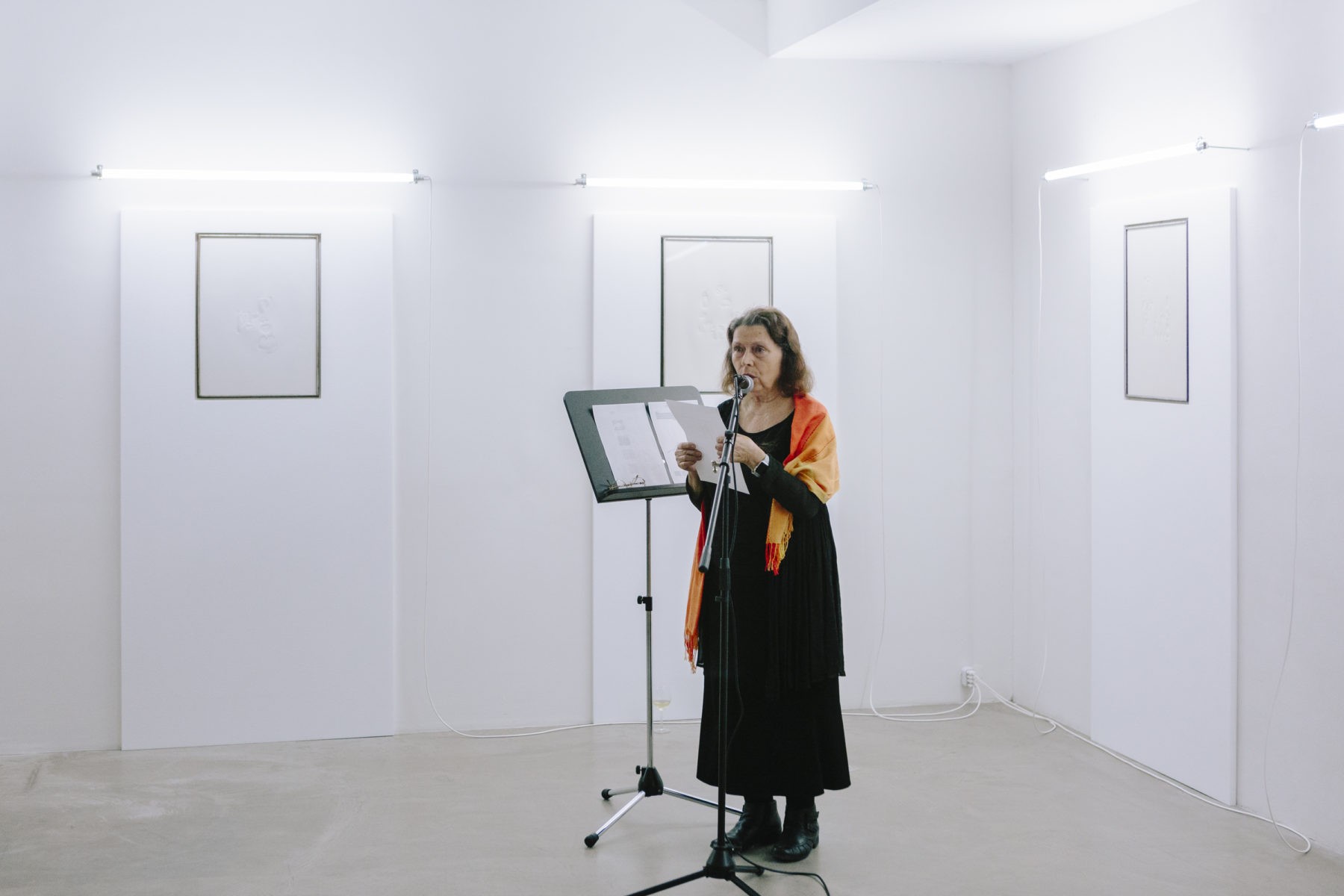
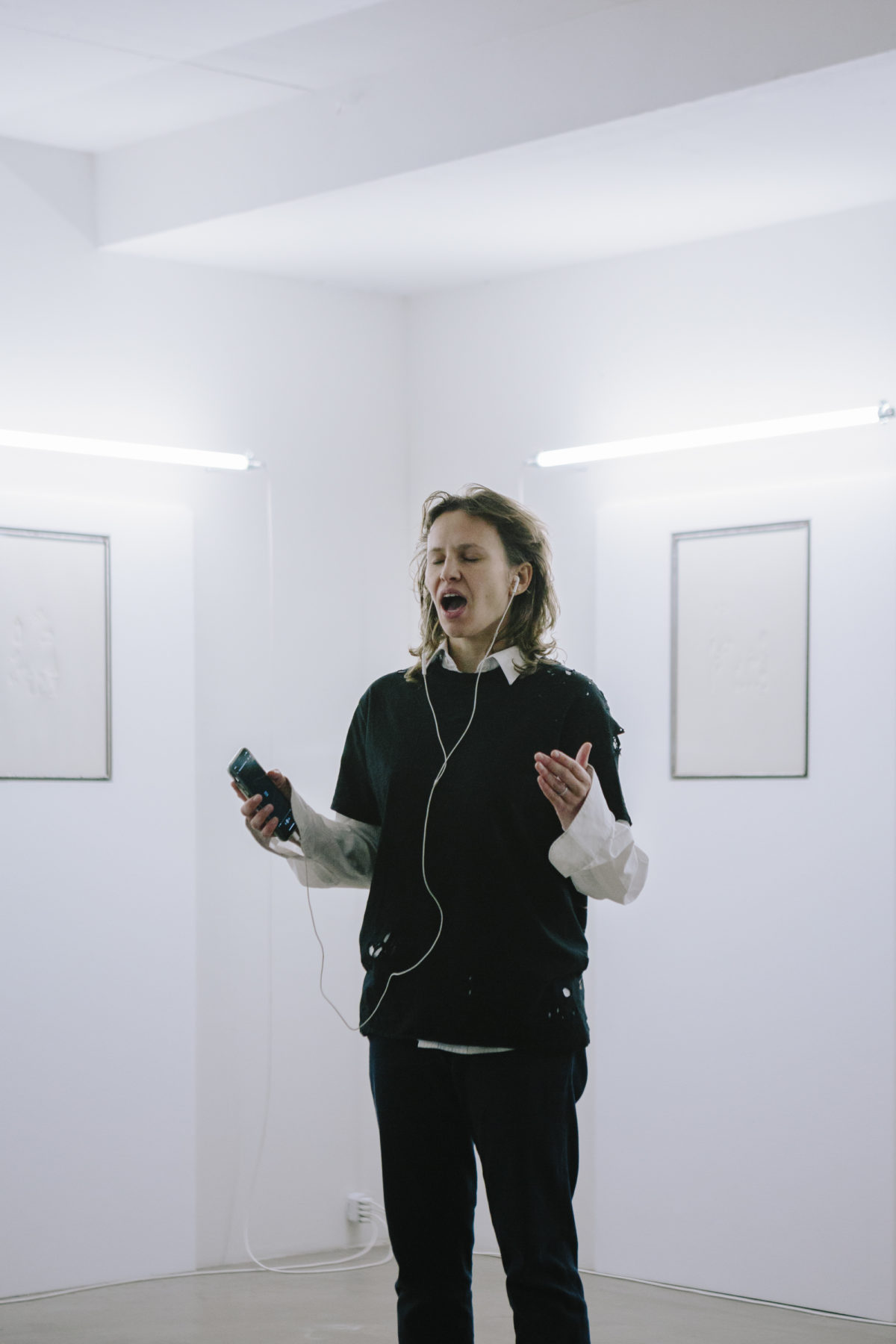
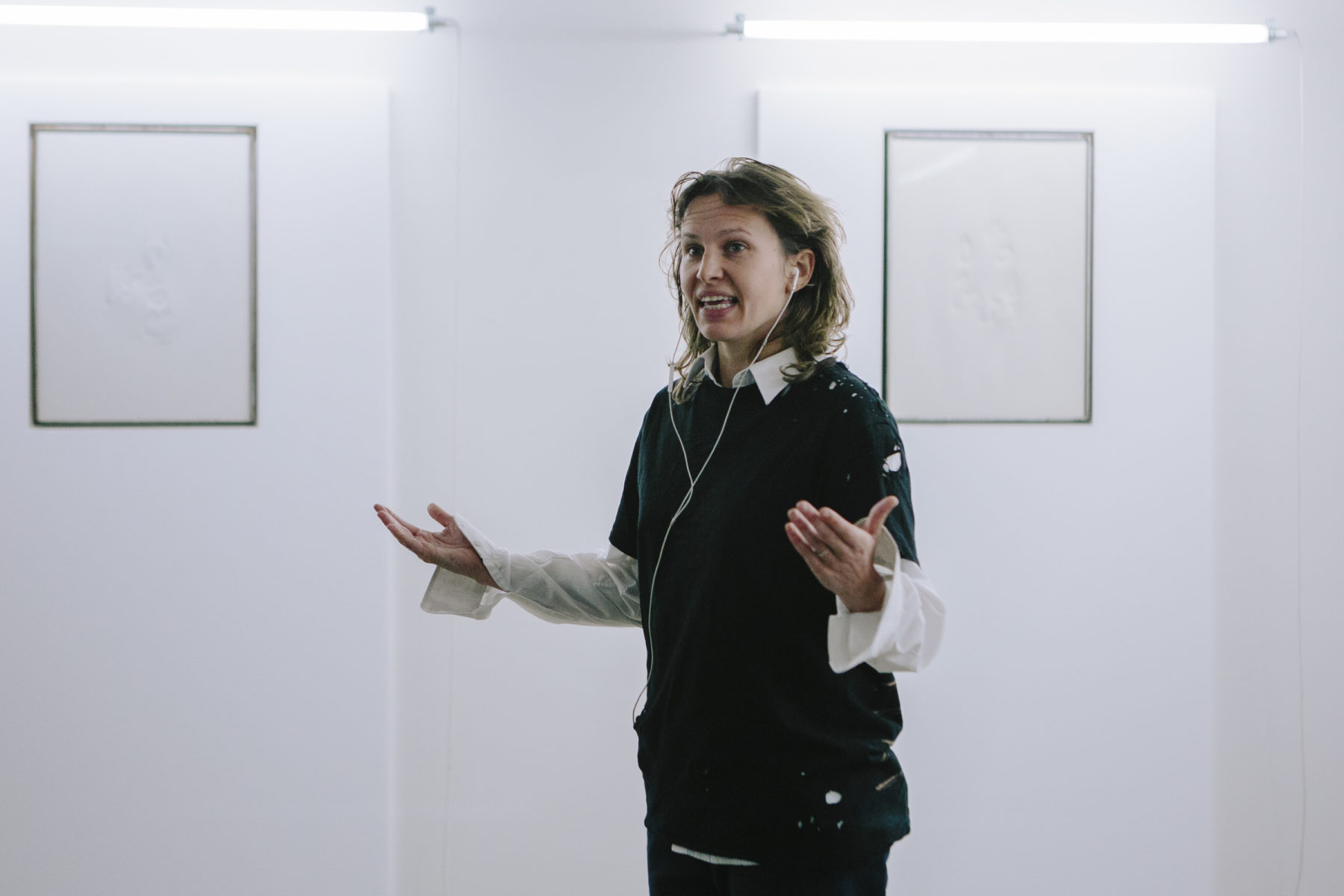
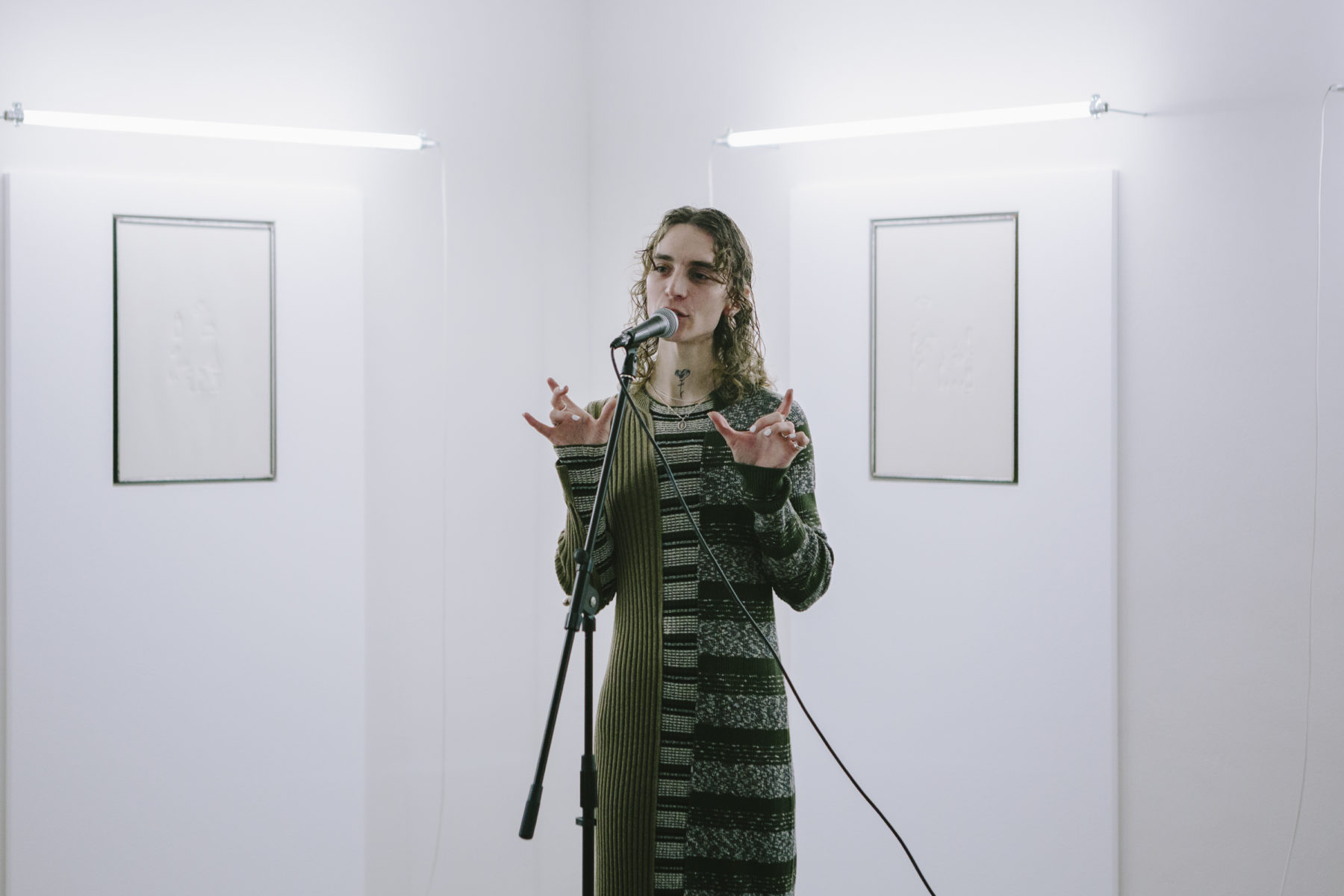
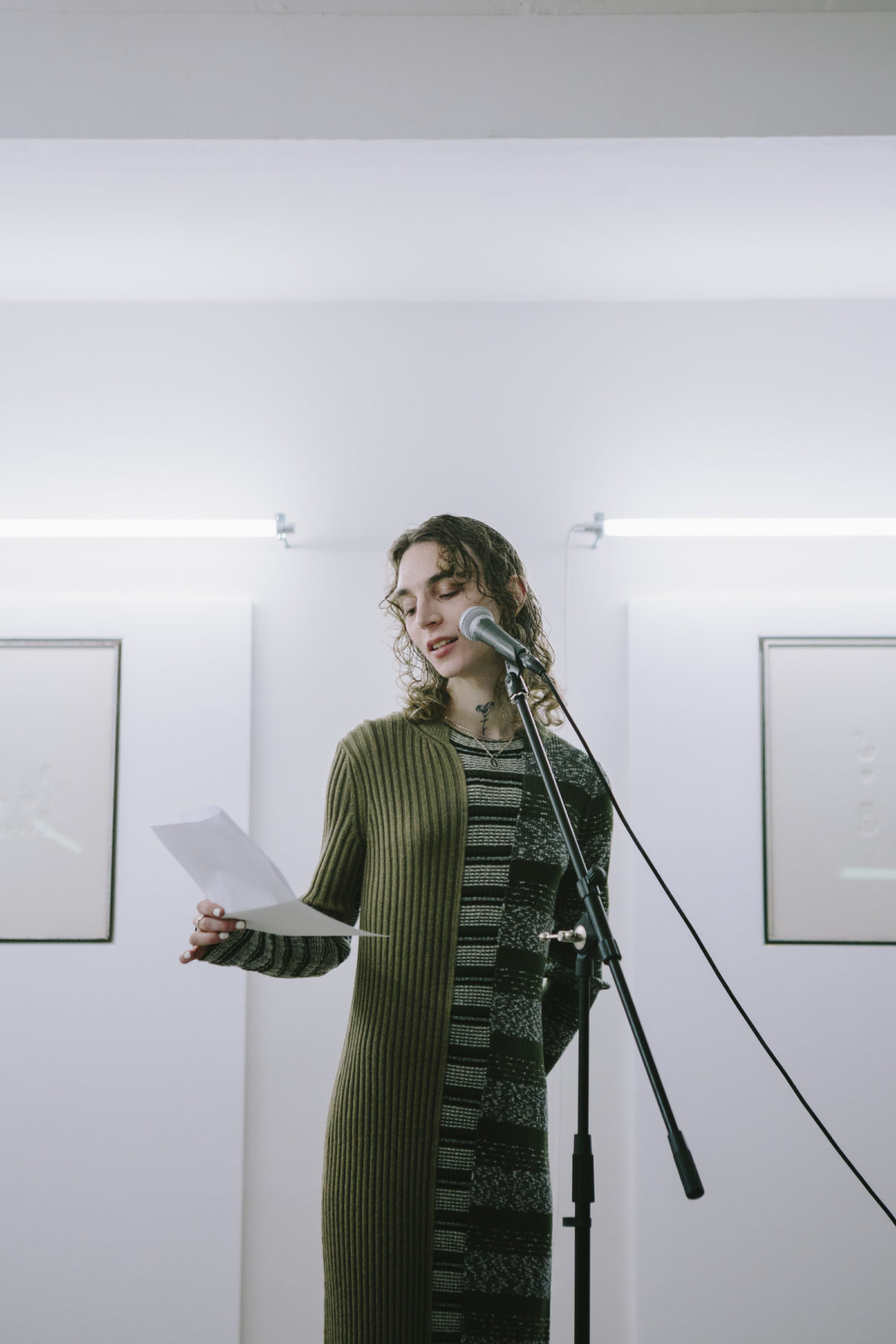
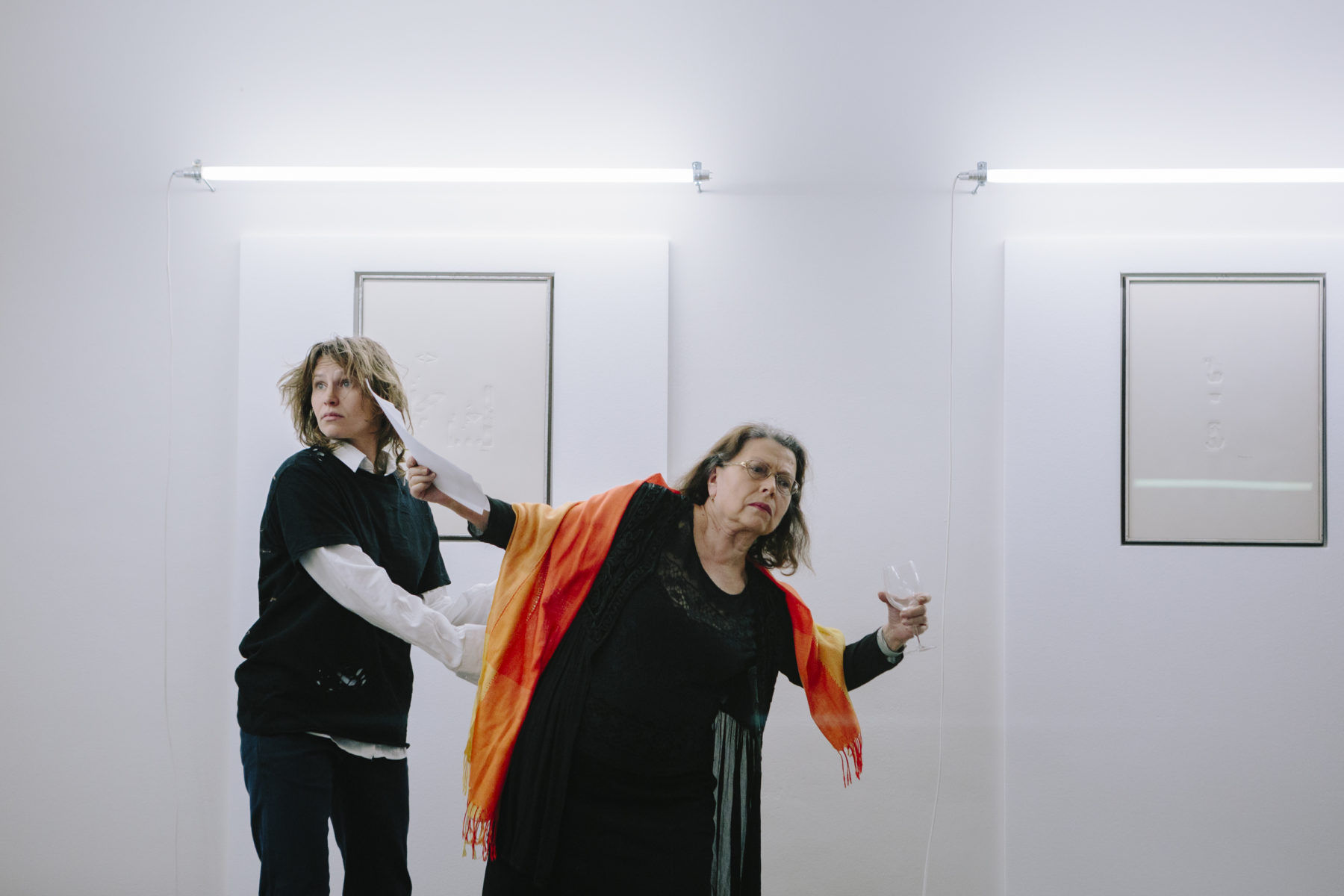
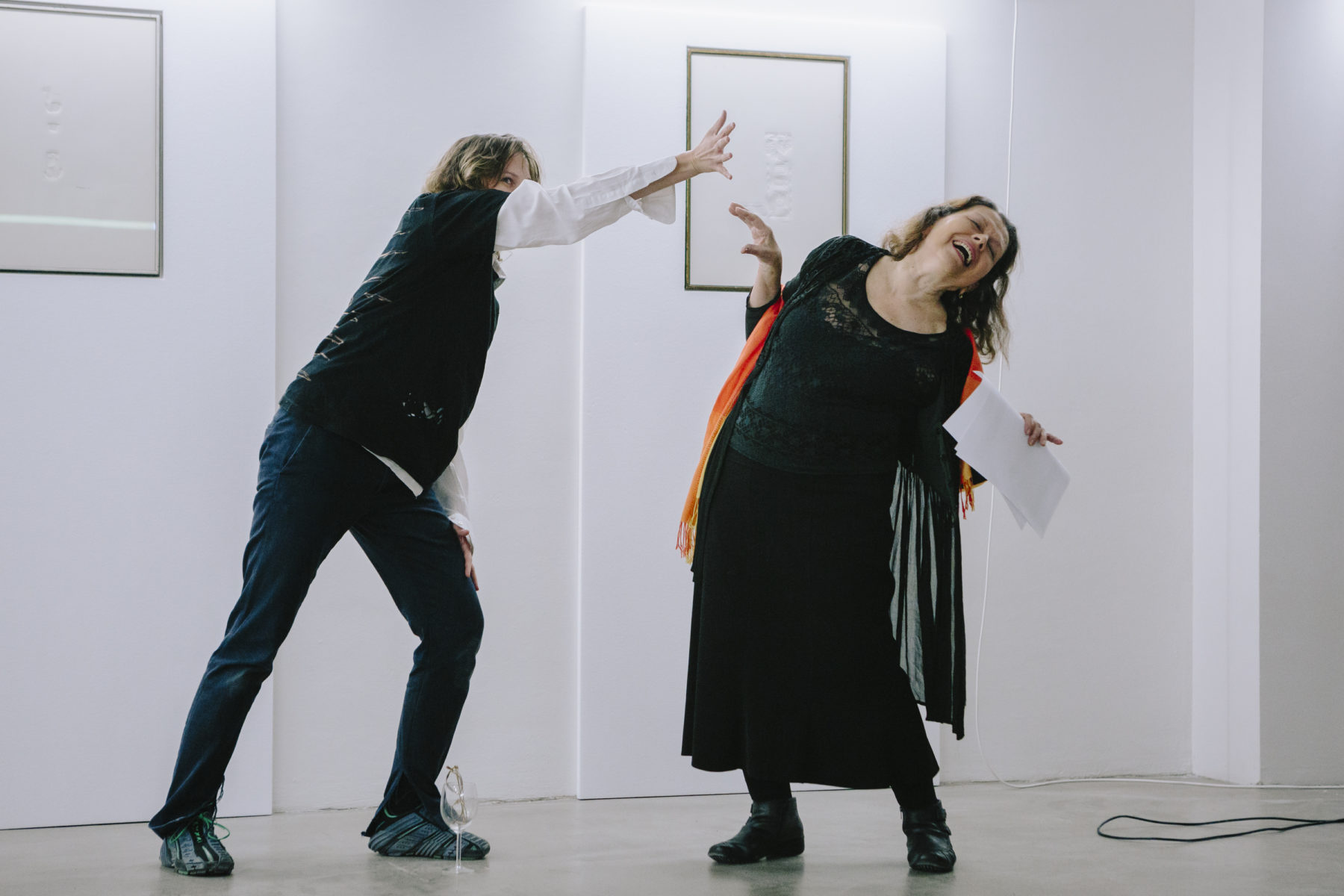
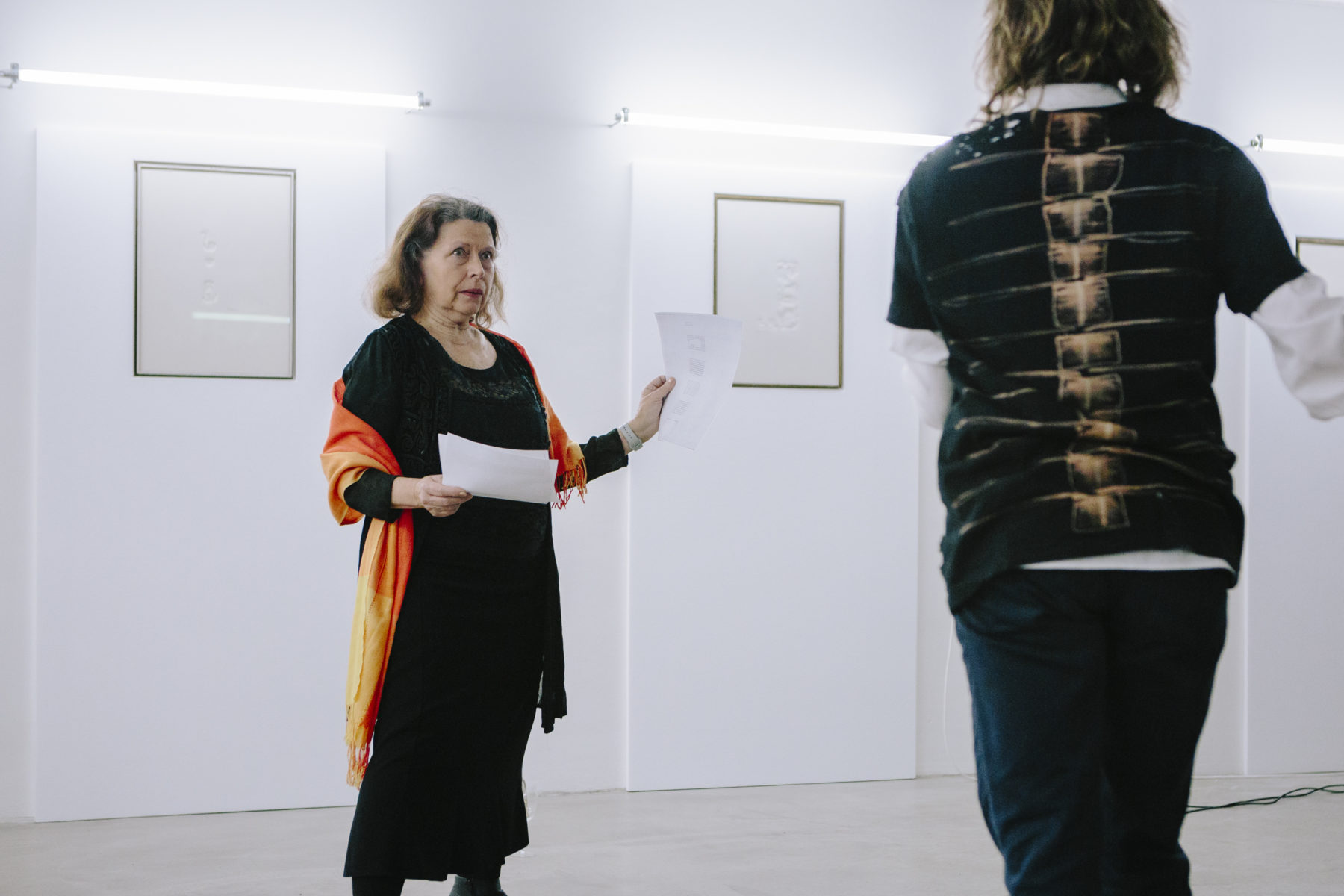
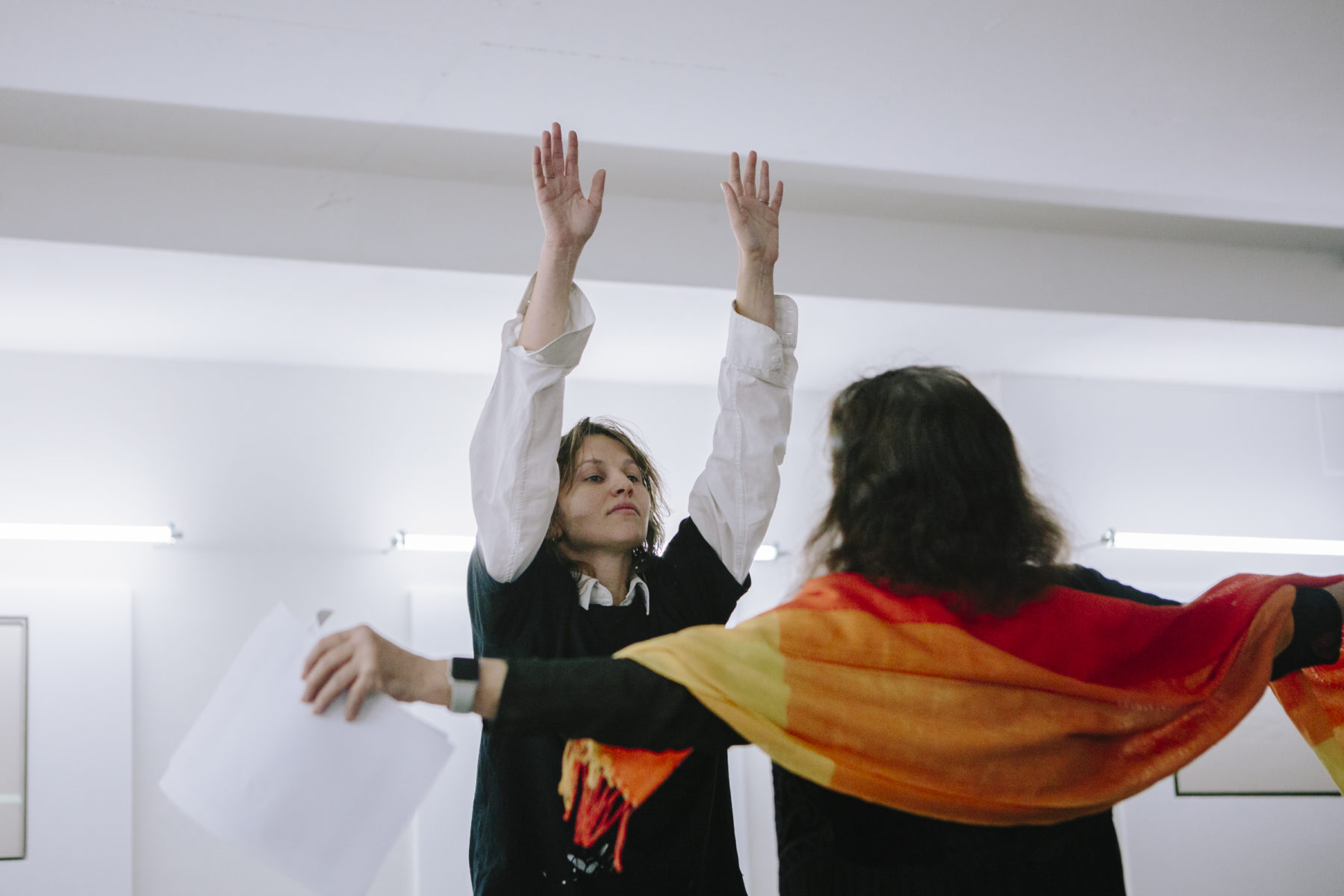
The Weight of the Concrete marks the first monographic exhibition of Ezio Gribaudo (Turin, 1929-2022) in Austria. It serves as a comprehensive homage to his multifaceted career, offering an extensive exploration of his roles as both artist and publisher. The exhibition borrows its name from Il Peso del Concreto (1968), a seminal book that featured Gribaudo’s early graphic work alongside an anthology of concrete poetry edited by the poet Adriano Spatola. In line with his interdisciplinary approach, this exhibition explores Gribaudo’s idiosyncratic oeuvre, his poetics of matter, and the complex relationship he developed between image and language. Gribaudo’s work is then carried into the present by a scenography designed by the Italian artist Davide Stucchi. The exhibition is curated by Tom Engels and Lilou Vidal.
At the center of The Weight of the Concrete are the Logogrifi, Gribaudo’s emblematic series that he developed from the 1960s onward. Throughout his life, the Logogrifi have articulated a deep entanglement with his activities as a bookmaker, as well as his fascination for new industrial printing processes, typefaces, language games, and relief matrices. Grounded in linguistic or visual riddles, the Logogrifi are akin to logogriphs or puzzles that involve the formation of new words by permuting their initial letter. In Gribaudo’s interpretation, a Logogrifo oscillates between legibility and abstraction, at times verging toward readable forms and at others scaling the enigmatic world where image and language coalesce.
The Weight of the Concrete explores Gribaudo’s distinct poetic repertoire of forms—encompassing textual, figurative, and topographic elements, yet invariably disconnected from their provenance—which heralds the emergence of a new grammar and, consequently, novel forms of reading. Starting with achromatic embossments on blotting paper, transforming into wooden and polystyrene reliefs, and ultimately culminating in vividly chromatic pieces using typographic ink, the works persistently interrogate the ways in which form, language, and matter continue to shape and redefine one another. This transformation not only challenges traditional modalities of readership and perception, but also progressively slows down and intensifies the viewer’s experience, moving it from an exercise in deciphering the achromatic nature of the page to a vibrant and colorful encounter. This relentless experiment with printing technologies was sparked by his dedication to publishing artist monographs, featuring contemporaries such as Giorgio de Chirico, Jean Dubuffet, Marcel Duchamp, Francis Bacon, Lucio Fontana, Asger Jorn, and Wifredo Lam, as well as his interest in popular print formats like newspapers, dictionaries, atlases, and children’s books. To emphasize this non-hierarchical relationship between his artistic work and publishing activities, the exhibition’s final chapter presents a unique selection of Gribaudo’s rare publications and archival materials.
The Weight of the Concrete gathers these graphic and poetic operations with the support of Davide Stucchi’s spontaneous gestures and conceptual responses. Drawing from Stucchi’s longstanding practice of using ready-made objects and industrially produced materials, his scenography reflects a mutual fascination for the industrial reproduction and repurposing of standardized materials. Operating at the intersection of visual arts, design, fashion, and scenography, Stucchi’s interventions echo and amplify Gribaudo’s interdisciplinary body of work.
The Weight of the Concrete will be complemented by two namesake publications. The first, which will be released alongside the opening at Grazer Kunstverein, will showcase photographic excerpts from Gribaudo’s achromatic embossed Logogrifi books (1965-1972), uniquely complemented with an intervention by Stucchi. The second publication reflects the editorial premise of Gribaudo’s and Spatola’s Il Peso del Concreto (1968). It revisits and reimagines this publication and the archive of its making, pairing Gribaudo’s graphic work with a new selection of historical and contemporary concrete and experimental poetry. It will also include essays elucidating the interplay between language, matter, and their poetic interconnections. Published by Axis Axis and Grazer Kunstverein, it is scheduled for release in the summer of 2024.
The Weight of the Concrete will also feature a sound program, The Weight of the Tongue, which serves as a speculative prelude to the upcoming publication. Focusing on the vocalization of experimental poetry, the program will gather the voices of Tomaso Binga, CAConrad, Susan Howe and David Grubbs, Hanne Lippard, and Patrizia Vicinelli. Additionally, Katalin Ladik, Bryana Fritz, and Nat Marcus will contribute to the program and perform their work at the opening of the exhibition.
An additional public program, taking place in early 2024, will delve into the intrinsic relationship between concrete poetry, publishing, graphic design, typeface, feminism, and performative practices. Contributors to this program include Mónica de la Torre, Alex Balgiu, Andrea di Serego Alighieri, and others.
The public program and the publications are curated and edited by Tom Engels and Lilou Vidal.
EZIO GRIBAUDO (1929-2022, Italy) was an artist and art publisher based in Turin. Gribaudo’s work, notable for its fusion of figurative, textual, and topographical elements, was shaped by his expertise in typography, industrial printing, and publishing. He managed the Edizione d’Arte Fratelli Pozzo publishing house and was instrumental in the Le Grandi Monografie series by Fabbri Editori, producing monographs on artists such as Karel Appel, Francis Bacon, Alberto Burri, Giorgio de Chirico, Marcel Duchamp, Man Ray, Joan Miró, Henry Moore, Antoni Tàpies, among others. In collaboration with Michel Tapié, he contributed to the ICAR (International Center of Aesthetic Research) in 1960. Gribaudo was also committed to curatorial projects, such as the exhibition of the Peggy Guggenheim Collection at Galleria Civica d’Arte Moderna, Turin, in 1976, and Jean Dubuffet’s exhibition-performance CouCou Bazar at Promotrice delle Belle Arti with FIAT in 1978.
Ezio Gribaudo’s artistic trajectory is characterized by a prolific exhibition history. His work has been featured in exhibitions both in Italy and internationally since the late 1950s and continues to be exhibited to this day. A small selection of solo exhibitions includes: Galleria d’Arte La Bussola, Turin (1959); Galleria Schwarz, Milan (1967/1972); Galleria la Bertesca, Genoa (1967); Galleria Viotti, Turin (1968); Galerie de France, Paris (1968); Kunstverein Göttingen (1971); Petit Palais, Musée d’Art Moderne, Geneva (1971); Museum of Modern Art, Rio de Janeiro (1973); Marlborough Graphics Gallery, London (1974); Galleria Michaud, Florence (1975); Etablissement d’en face, Brussels (2019); and Galerie Sans Titre, Paris (2022).
In addition, Gribaudo participated in significant exhibitions such as the 9th Rome Quadriennale (1965); the 33rd Venice Biennale (1966); Salon de Mai, Paris (1967); Salon de Mayo, Havana (1967); the 9th São Paulo Art Biennial (1967); Stedelijk Van Abbemuseum, Eindhoven (1967); GAM (Galleria Civica d’Arte Moderna), Turin (1967); Salon de Mai, Paris (1968); Museum of Modern Art, Caracas (1968); The National Gallery, Prague (1969); the 8th International Exhibition of Graphic Arts, Ljubljana (1969); the 10th Rome Quadriennale (1973); Fundação Calouste Gulbenkian, Lisbon (1979); International Exhibition of Graphic Arts, Bilbao (1982); Grand Palais, Paris (1982); Castello di Rivoli, Rivoli (1986); the Italian Pavilion at the 54th Venice Biennale (2011); Sandretto Re Rebaudengo Foundation, Turin (2015); Peggy Guggenheim Collection, Venice (2016); Museo del Novecento, Milan (2017); GAM (Galleria Civica d’Arte Moderna), Turin (2017); Pio Pico Gallery, Los Angeles (2020); and MACRO Museum of Contemporary Art of Rome (2021).
DAVIDE STUCCHI (b. 1988, Italy) lives and works in Milan. He works at the intersection of visual art, fashion, advertising, scenography, and domesticity, exploring pre-existing materials through minimal gestures and interventions. With a conceptual and poetic approach, Stucchi creates installations and sculptures that reveal absent bodies and intimate stories through the tangibility and vulnerability of the objects. His recent solo exhibitions include Clin d’oeil, with Luisa Gardini, Ermes Ermes, Rome (2022); Falli (Phalluses), Martina Simeti, Milan (2021); DS, Deborah Schamoni, Munich (2020); 2546/9728, Sundogs, Paris (2019); Davide Stucchi con Corrado Levi, zazà, Naples (2019); and Light switch (Entrance), Gregor Staiger, Zurich (2019), among others. His work has been featured in group exhibitions at Mendes Wood DM, Paris (2023); Between Bridges, Berlin (2023); Palazzo Ducale, Genoa (2023); Marsèll, Milan (2022); Fitzpatrick Gallery, Paris (2021); MACRO Museum of Contemporary Art of Rome (2020); the 17th Rome Quadriennale, Palazzo Delle Esposizioni, Rome (2020); Stadtgalerie Bern (2020); Fondazione Sandretto Re Rebaudengo, Turin (2018); Kunstverein Düsseldorf (2017); the 16th Rome Quadriennale, Palazzo Delle Esposizioni, Rome (2016), among others. Since 2017, Stucchi has been active as a set designer for various fashion labels, culminating in his latest collaboration with Magliano since 2021.
The Weight of the Concrete is realized in collaboration with Museion—Museum of Modern and Contemporary Art in Bolzano-Bozen, Italy, where it will be on view from March 23 to September 1, 2024, and with the Archivio Gribaudo in Turin, Italy.
The project is supported by the Directorate General for Contemporary Creativity of the Italian Ministry of Culture under the Italian Council program (12th edition, 2023), which aims to promote Italian contemporary art worldwide.

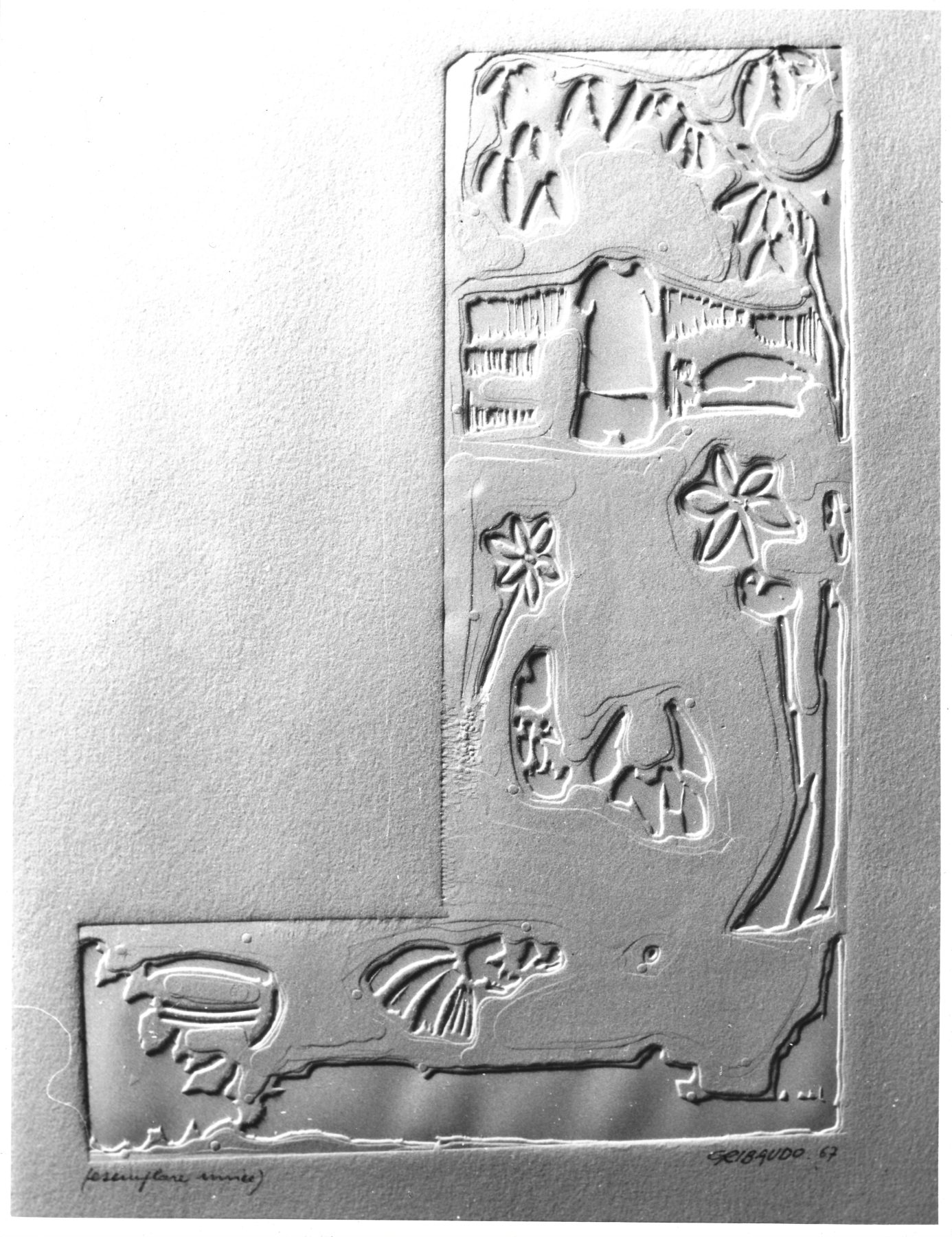
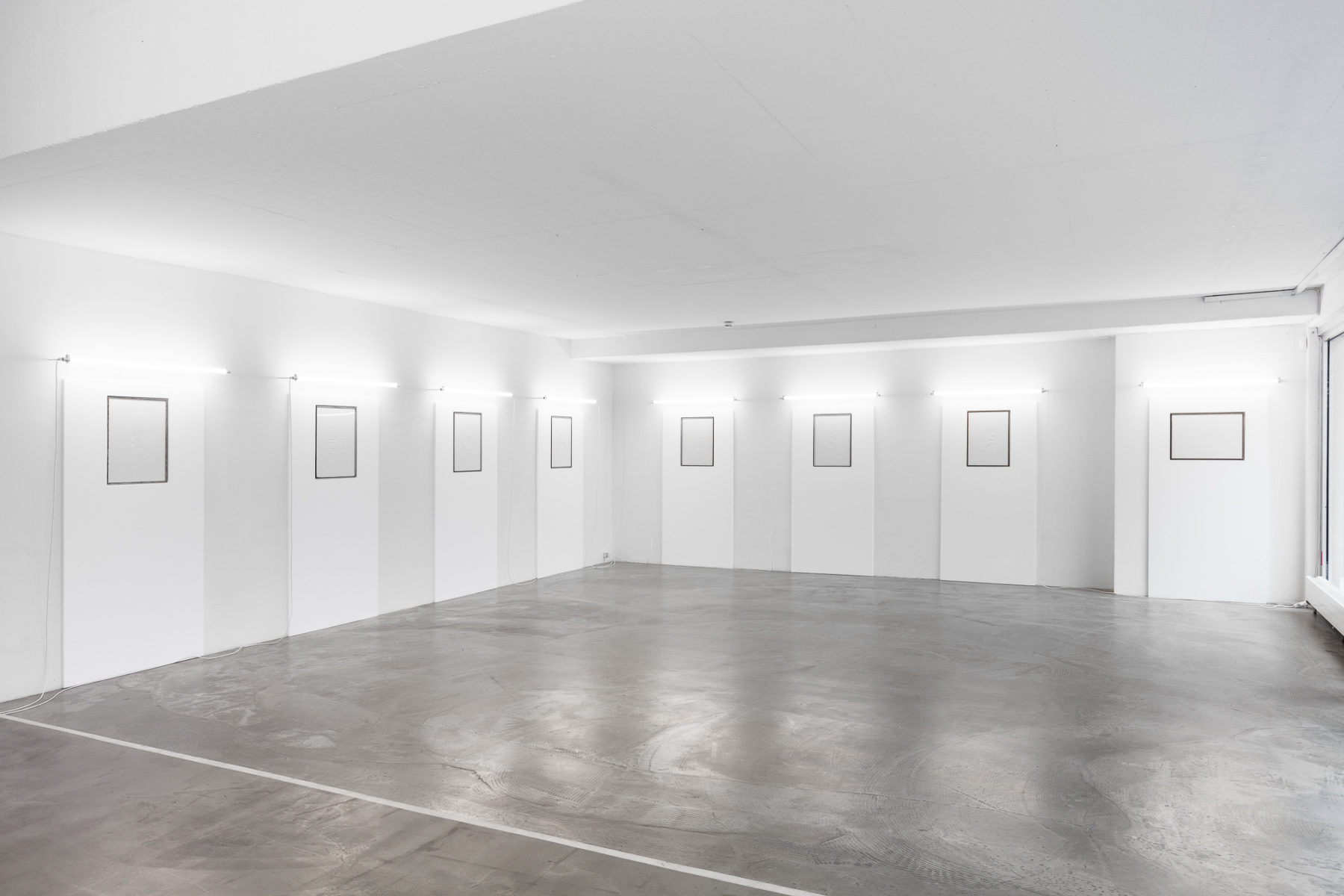
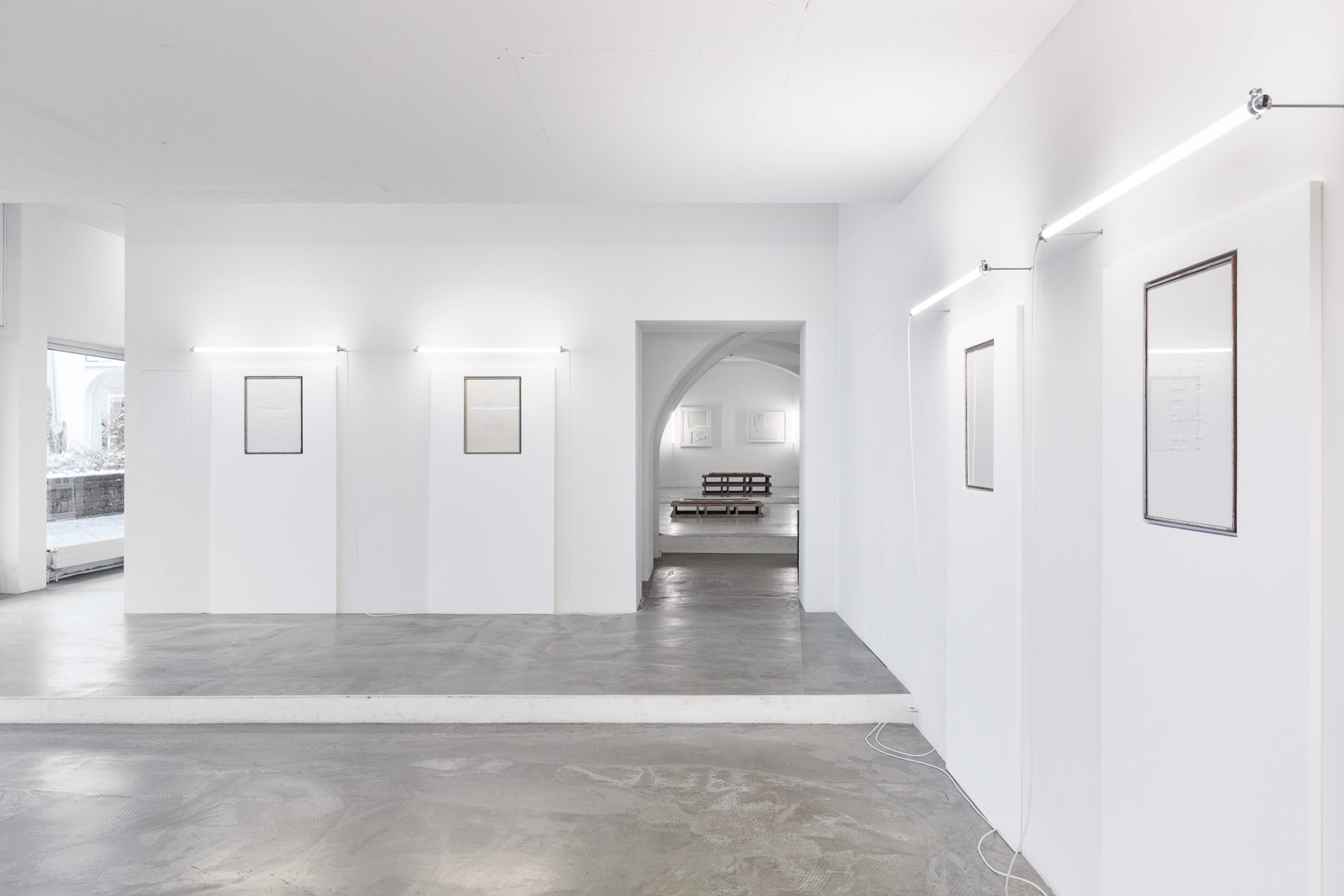
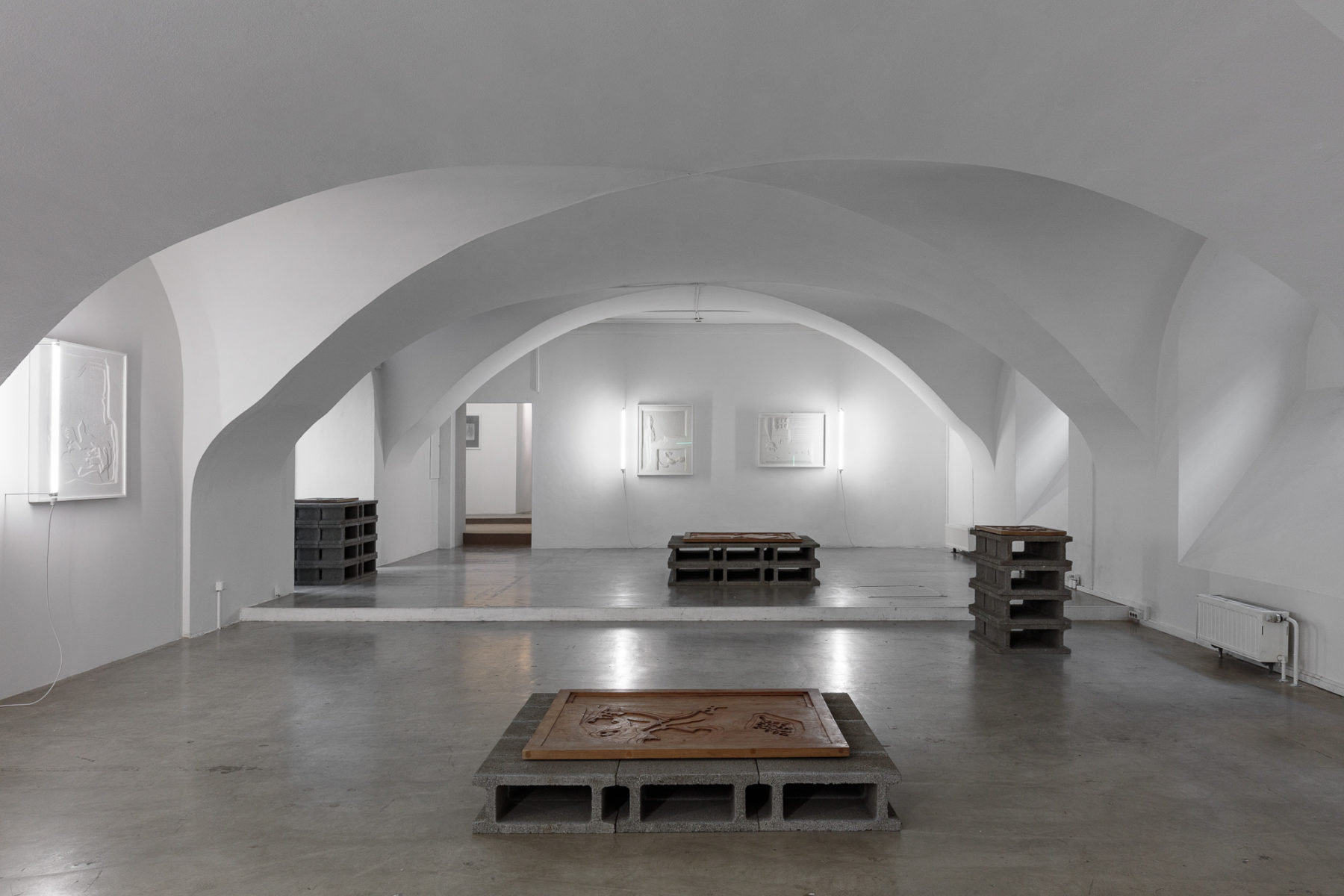
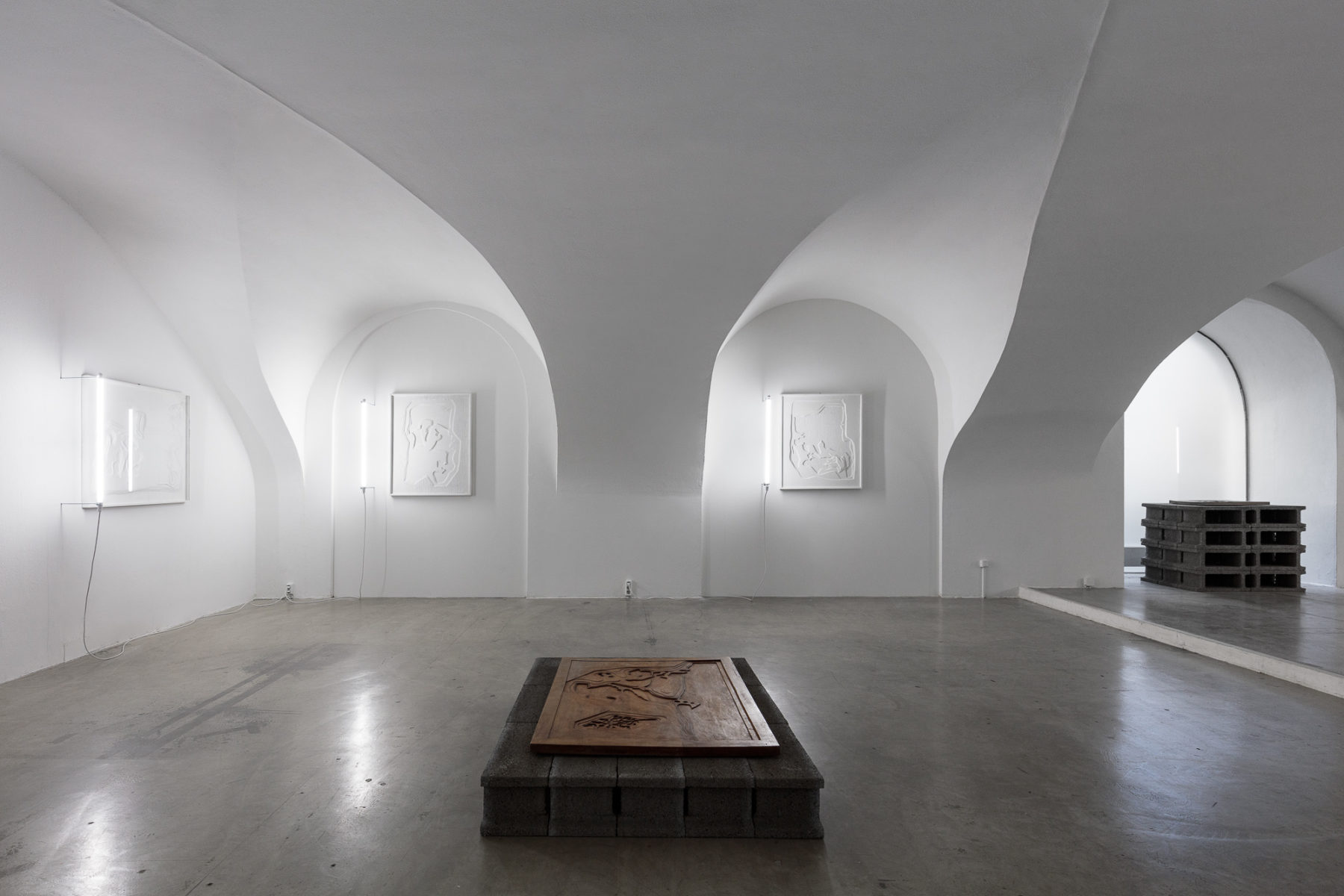
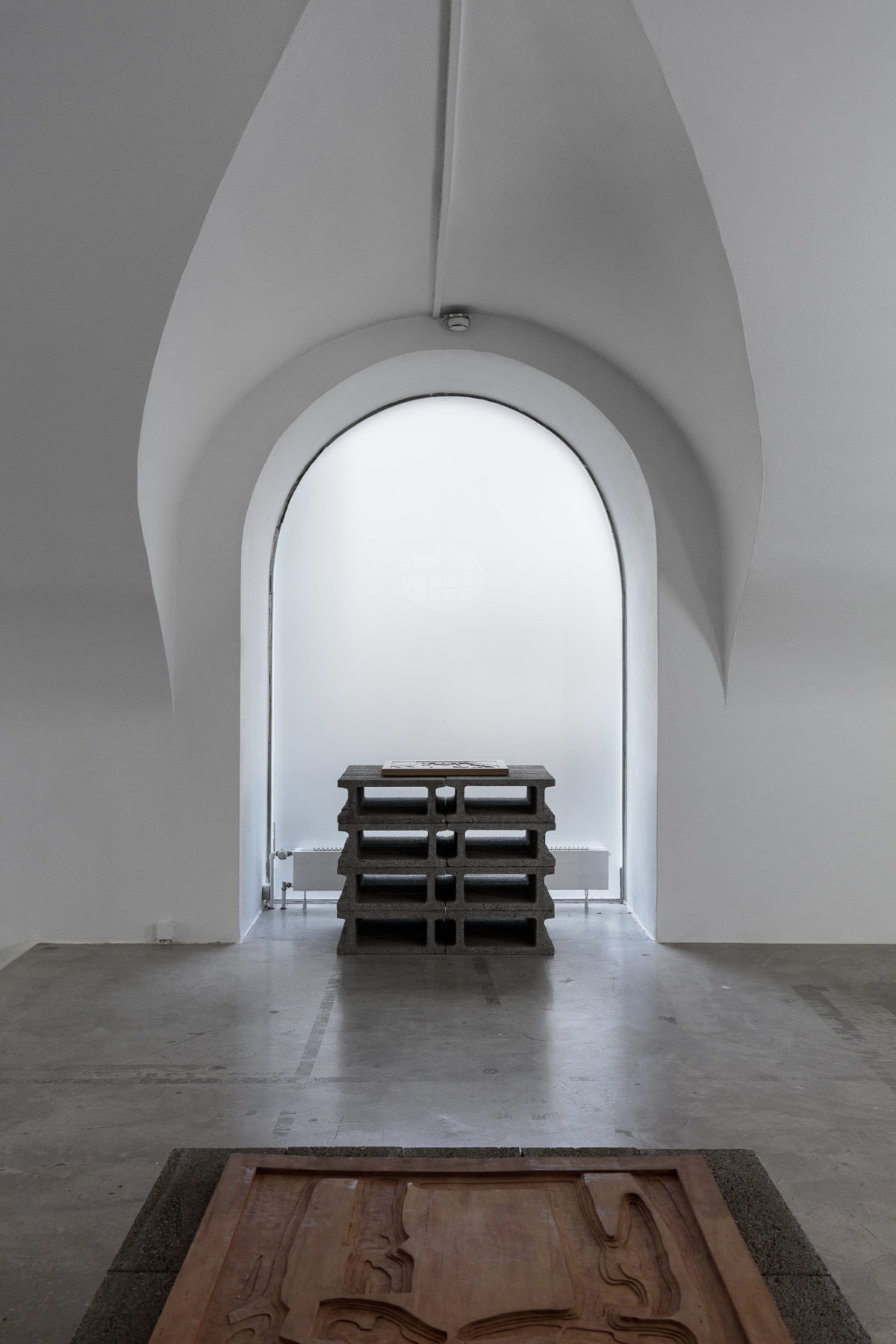
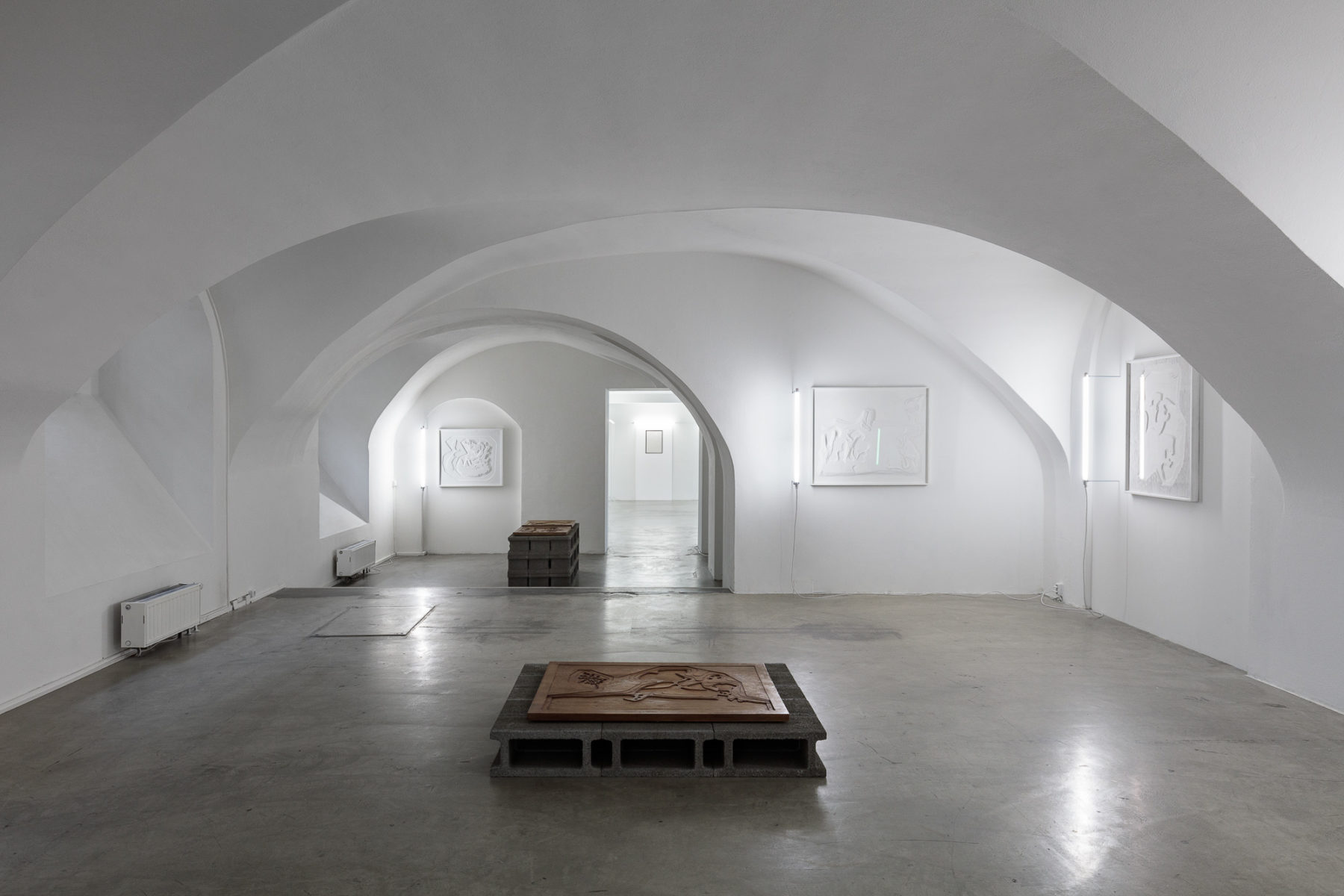
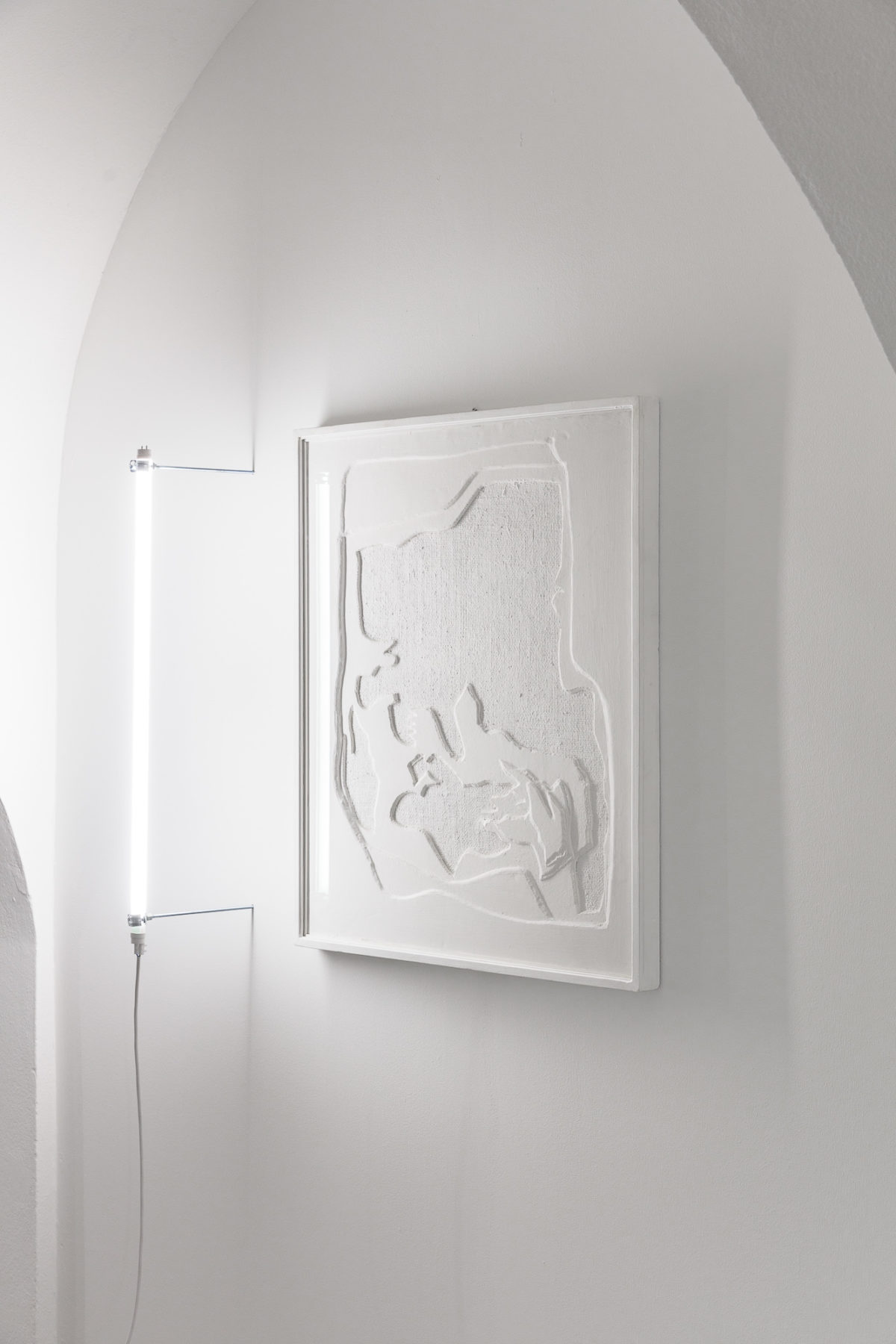
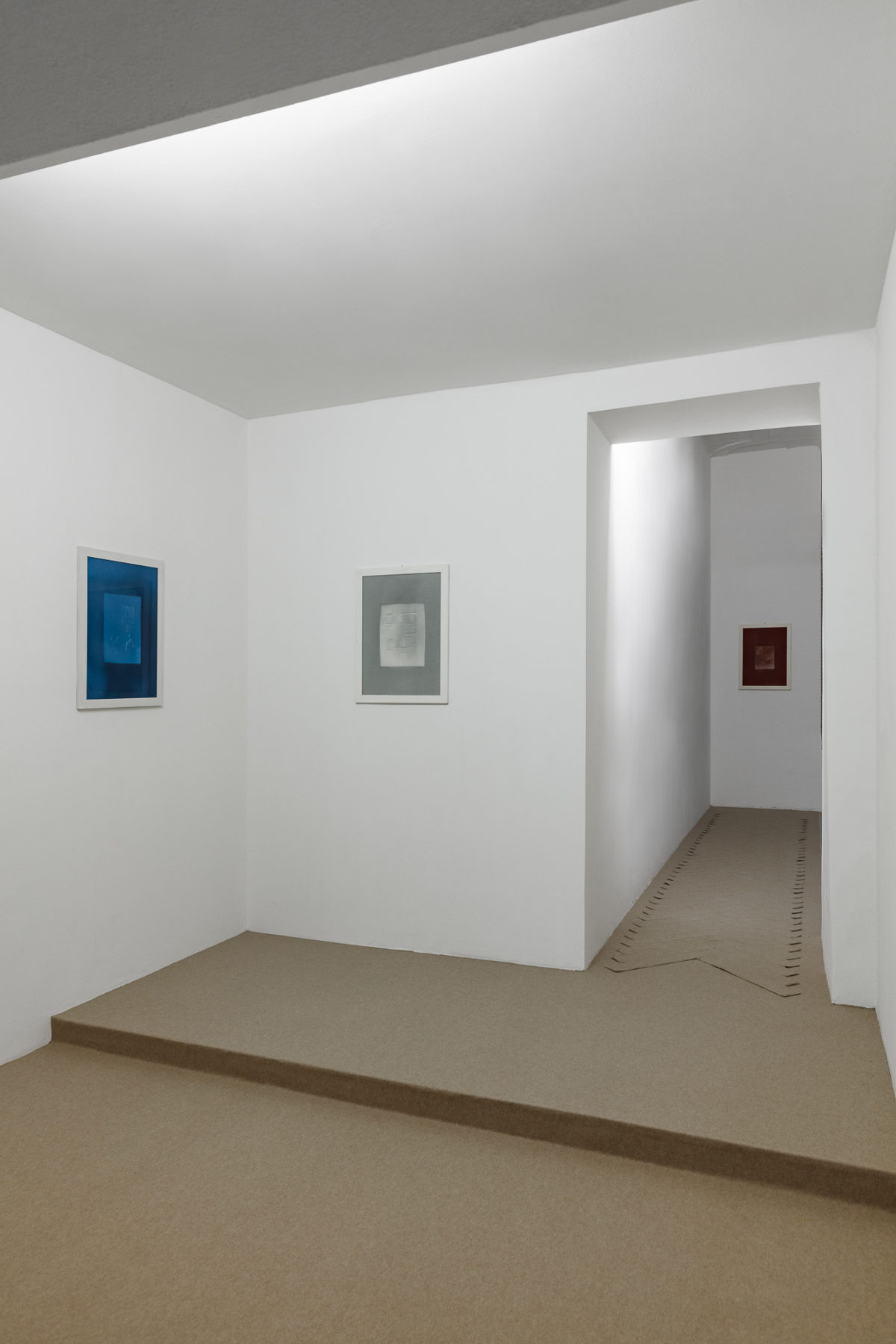


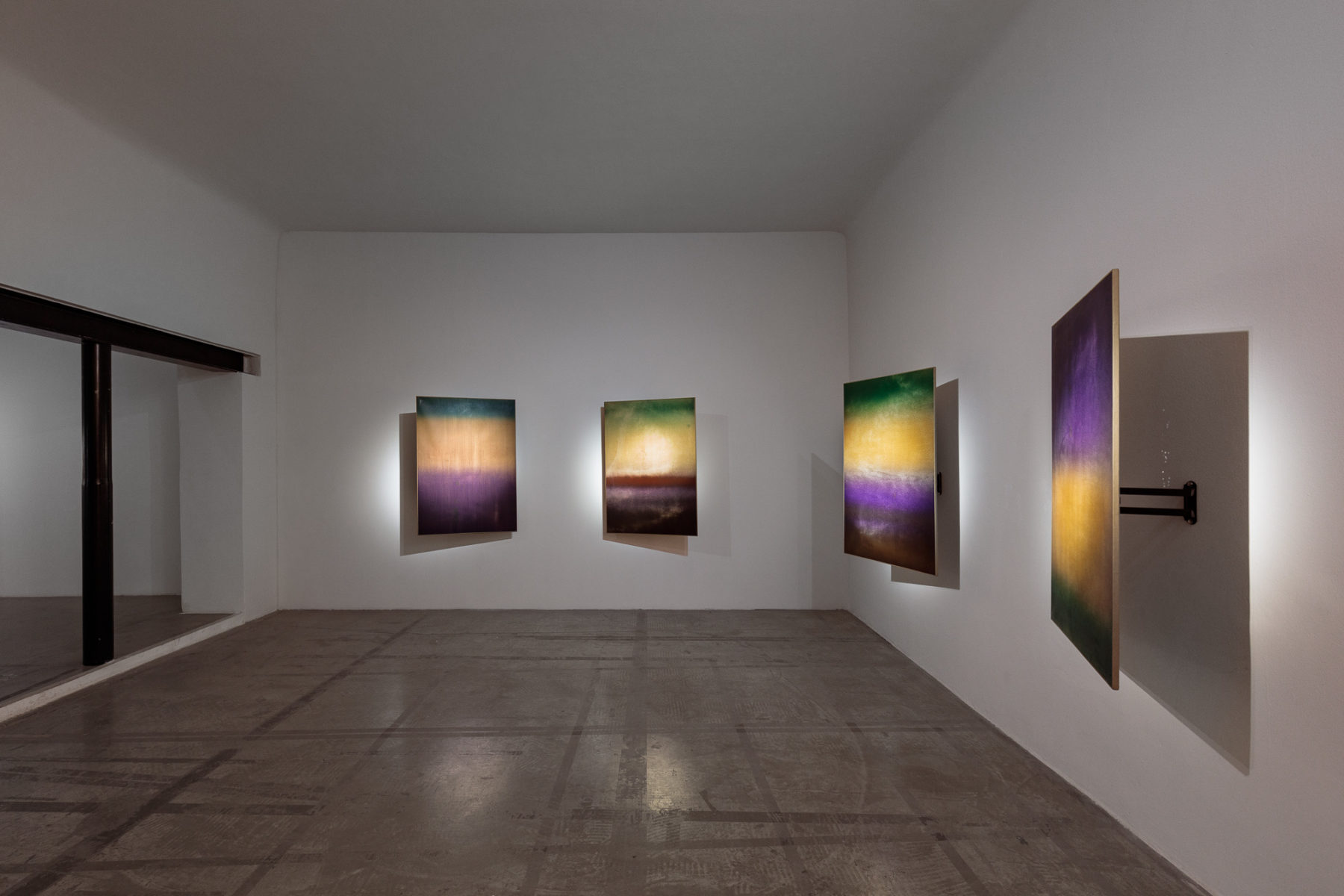
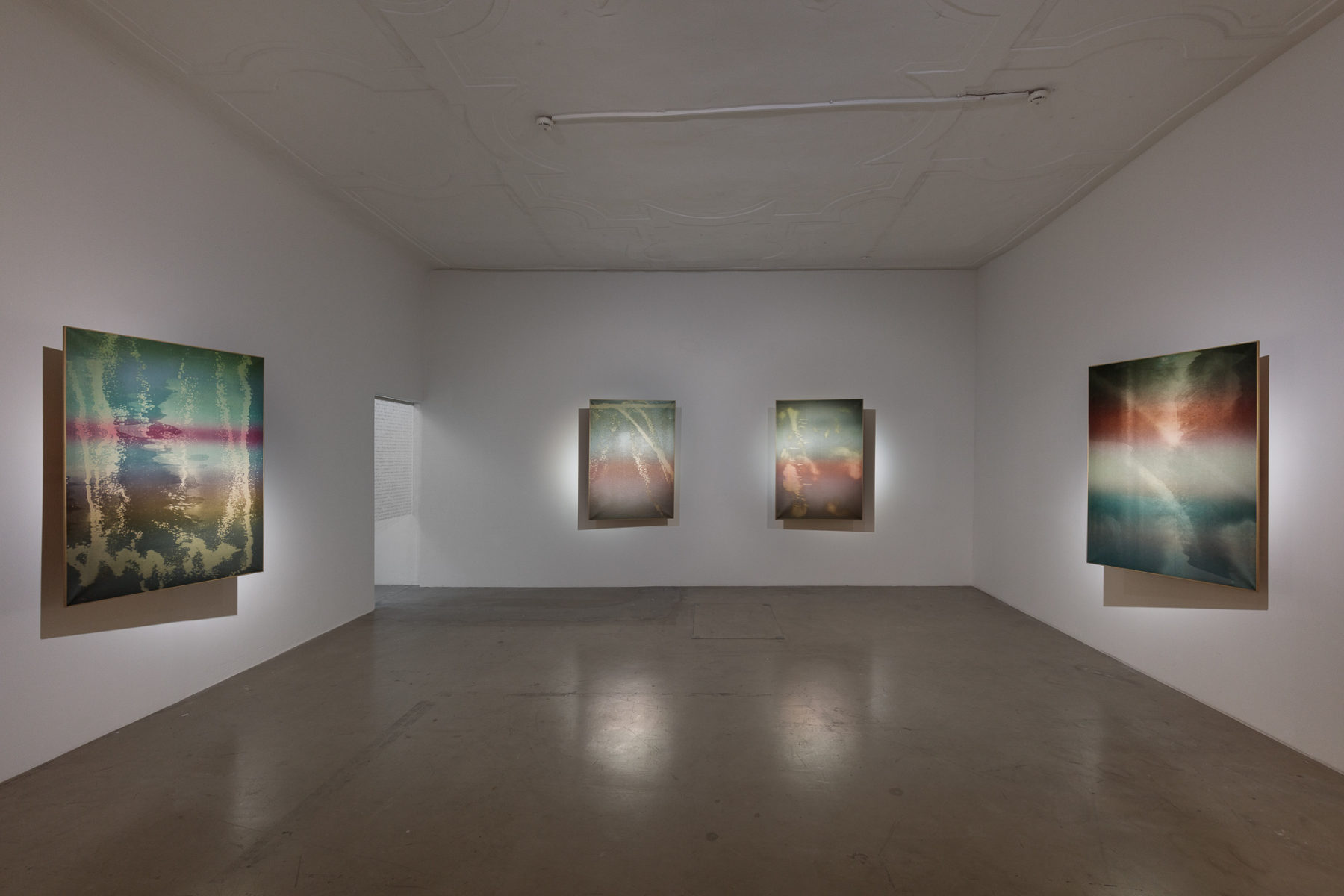
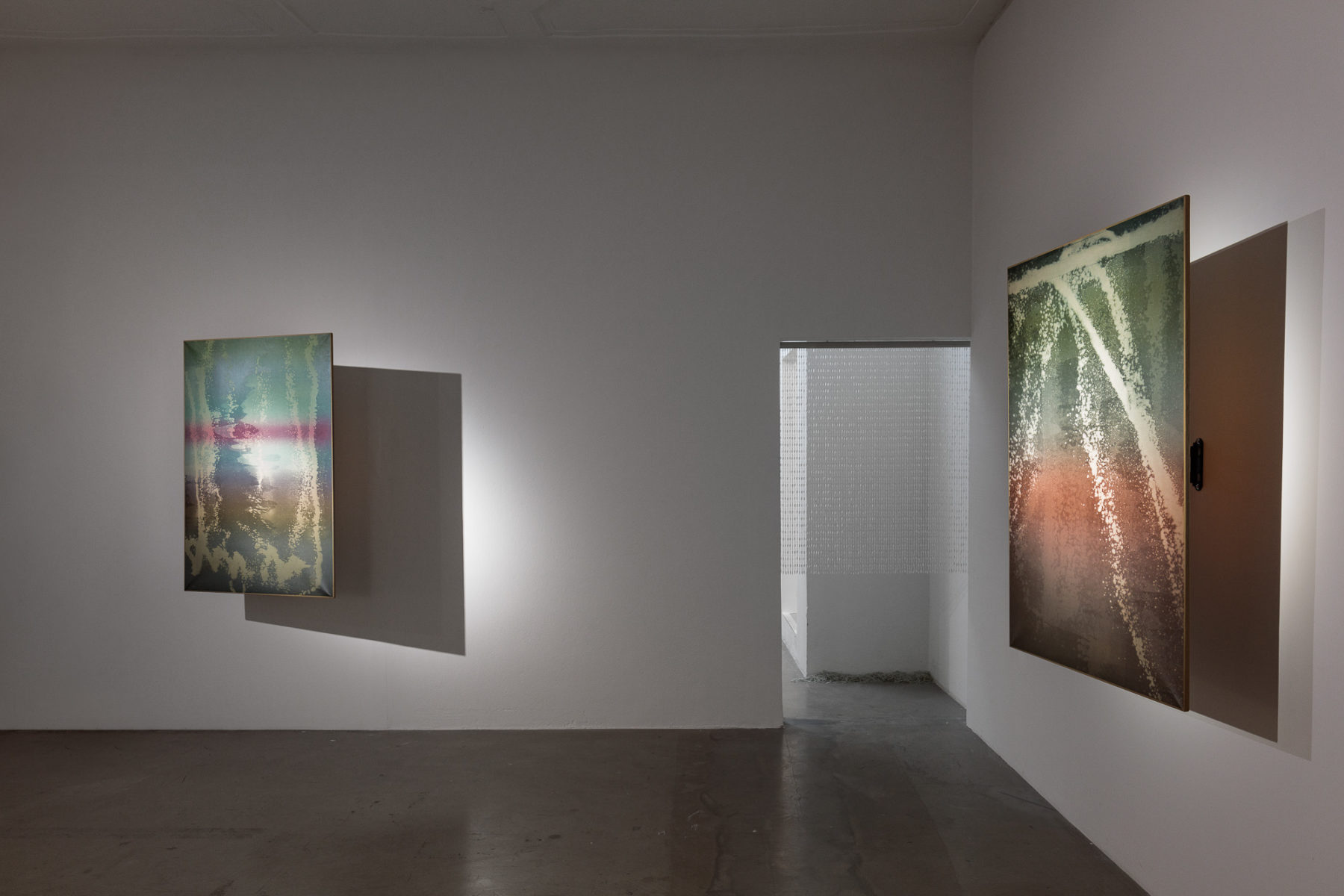
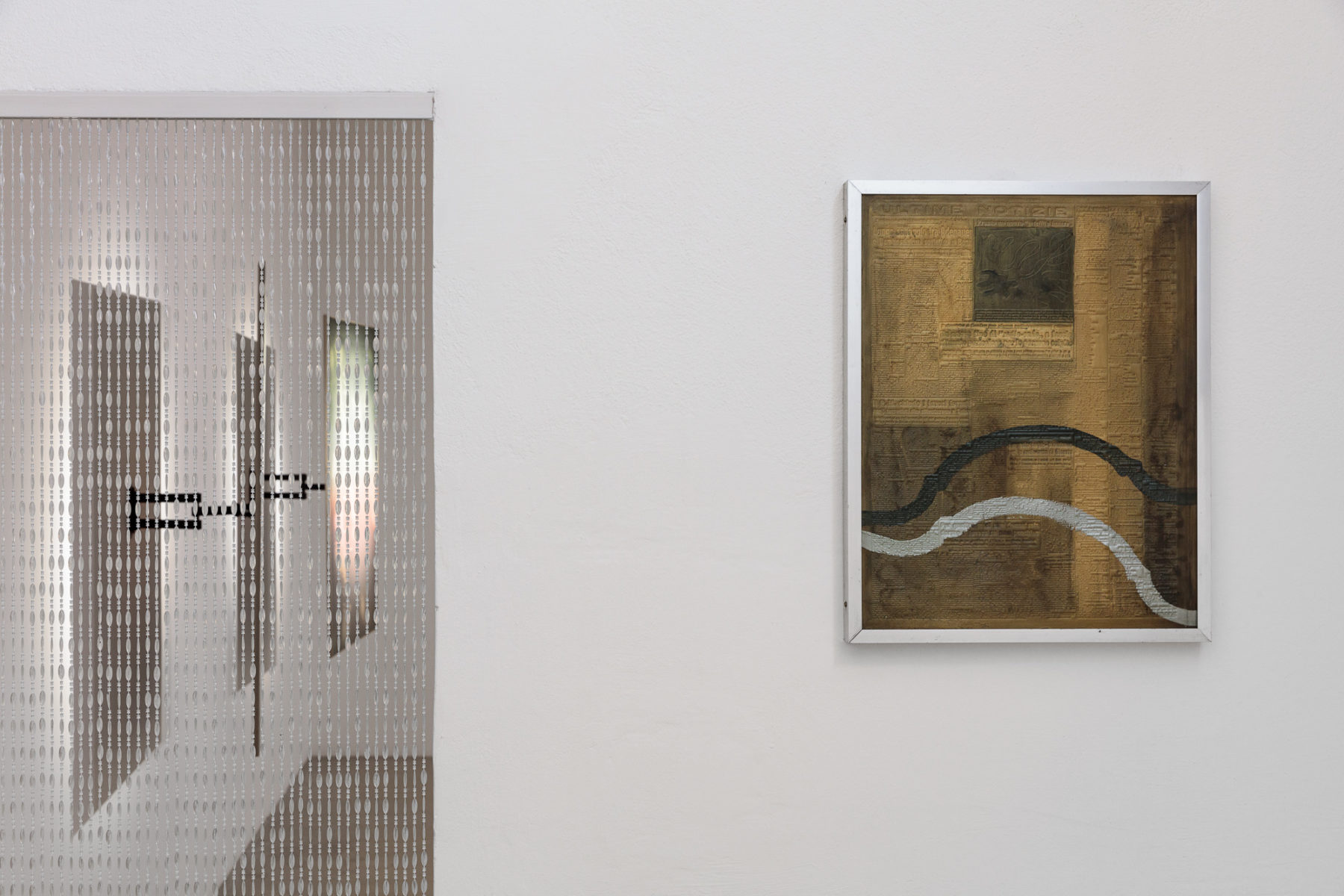
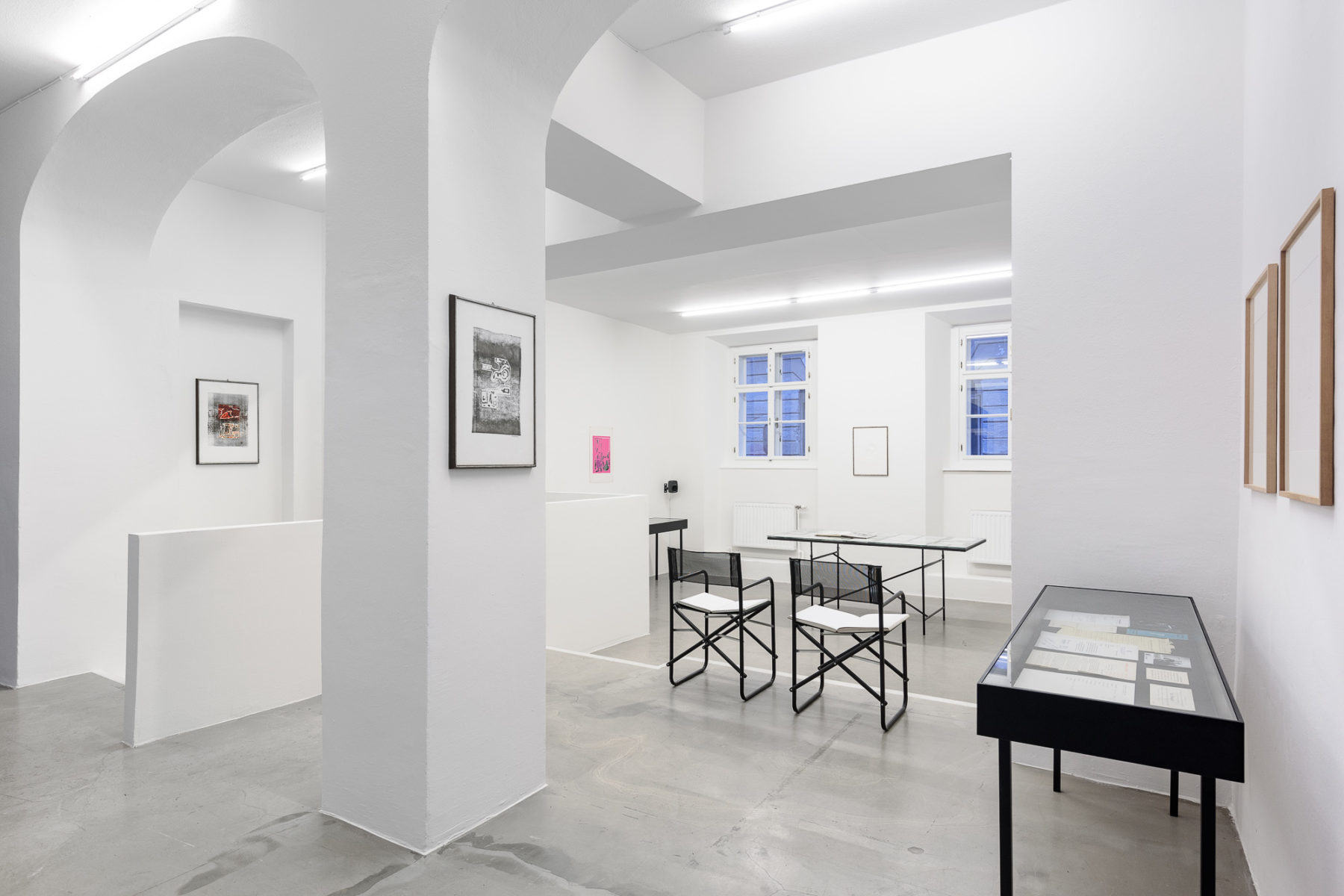
This publication coincides with the exhibition Until Due Time, Everything Is Else by Pan Daijing. It is the sixth entry in a series of compact volumes featuring visual contributions, correspondence, responses, and conversations accompanying the Grazer Kunstverein exhibition program.
The images within this book are excerpts from a video created by Pan Daijing. This publication is intended to act as a sixth screen, aligning with a five-channel video installation on display in Until Due Time, Everything Is Else at Grazer Kunstverein.
Editor: Tom Engels
Image: Pan Daijing
Graphic Design: Julie Peeters
Printing and Binding: Benedict Press, Münsterschwarzach
Edition: 350
Typeface: Kleisch GK by Chiachi Chao
128 pages, color
ISBN: 978-3-9505230-5-8
Price: 13,- euro, 7,- euro for members
This publication appeared in conjunction with the exhibition Colorless Green Freedoms Sleep Furiously by Miloš Trakilović. It is the fifth in a series of small volumes of correspondence, responses, and conversations, which accompanies the exhibition program of Grazer Kunstverein.
The publication features a newly commissioned essay by Edwin Nasr, as well as an interview between Elena Petrović and Miloš Trakilović conducted on the occasion of the exhibition.
Editor: Tom Engels
Graphic Design: Julie Peeters
Printing and Binding: Benedict Press, Münsterschwarzach
Edition: 350
Typeface: Kleisch GK by Chiachi Chao
64 pages, color, English
ISBN: 978-3-9505230-4-1
Price: 9,- euro, 5,- euro for members
This publication appears in conjunction with the exhibition sekretas by Marija Olšauskaitė. It is the fourth in a series of small volumes of correspondence, responses, and conversations, which accompanies the exhibition program of Grazer Kunstverein.
secrets gathers words, plants, and glass contributed by Elena Narbutaitė, Marija Olšauskaitė, Maria Tsoy, Aleksandra Krivulina, and Tom Engels.
Editor: Tom Engels
Guest Editor: Elena Narbutaitė
Poems: Maria Tsoy
Photography: Marija Olšauskaitė
Graphic Design: Julie Peeters
Printing and Binding: Benedict Press, Münsterschwarzach
Edition: 350
Typeface: Kleisch GK by Chiachi Chao
64 pages, white on white with inlaid images
ISBN: 978-3-9505230-3-4
Price: 9,- euros, 5 for members
In Until Due Time, Everything Is Else, Pan Daijing crafts an evocative exploration of temporality, memory, and presence. Through an interplay of video, traces of performance, site-specific interventions, and sound, the exhibition delves into the impermanent and fleeting dimensions that shape her understanding of performance — a perception that might parallel existence itself.
Pan Daijing’s work typically thrives in the realm of the live, manifesting itself through durational performative situations, inhabited installations, concerts, and other intimate encounters with audiences. Until Due Time, Everything Is Else introduces a counterpoint: all elements of liveness are stripped away. Instead of witnessing the dynamism of bodies in space or the throbbing pulse of live sound, visitors encounter only the echoes of such occurrences. Suggestions of presence are enveloped, hinted at, or harnessed by the exhibited works, and imbued with the vitality of what once was or what is to come.
Until Due Time, Everything Is Else gathers works of an ambiguous nature, as they mark the presence of something else, something that is not-here and not-now. They stand as materials crafted in moments of anticipation, as remnants from those very animate experiences, or as bearers of the procedural and intuitive displacements that happen when moving from one medium to another.
Reaching beyond the registers of performance documentation, these works are containers imprinted by transformative moments, and so embody or forecast change. As such, the exhibition directly confronts the paradox of the trace, which suggests that in attempting to capture or preserve an instance, one inadvertently alters or distorts its origins. Daijing’s pieces are a meditation on this paradox, emphasizing that traces, whether in memory or art or life, are both revealing and concealing, capturing both past and future whilst simultaneously eluding complete comprehension.
Until Due Time, Everything Is Else is complemented by a publication of the same name, which extends Pan Daijing’s exhibited multi-channel video installation to paper. It is edited by Tom Engels and designed by Julie Peeters.
Until Due Time, Everything Is Else is Pan Daijing’s first institutional exhibition in Austria and is curated by Tom Engels.
Pan Daijing (b. 1991, Guiyang, lives in Berlin) has shown her work internationally at the 14th Gwangju Biennale (2023); the Louvre, Paris (2023); Tai Kwun Contemporary, Hong Kong (2021); the 13th Shanghai Biennale (2021); Martin Gropius Bau, Berlin (2020); Tate Modern, London (2019); and the Biennale of Moving Image, Geneva (2018), among others. In 2024, Pan Daijing will present a solo exhibition at Haus der Kunst in Munich and, as the recipient of the Preis der Nationalgalerie, will exhibit at Hamburger Bahnhof in Berlin. She has performed at numerous venues and festivals including the Barbican Centre, London; Kraftwerk, Berlin; Elbphilharmonie, Hamburg; Berghain, Berlin; Sonar Festival, Barcelona; Haus der Kulturen der Welt, Berlin; and the National Pantheon, Lisbon. She has released three full-length albums: Tissues (2022), Jade (2021), and Lack (2017).
The exhibition is supported by ifa—Institut für Auslandsbeziehungen and is a cooperation in the context of steirischer herbst ’23.
